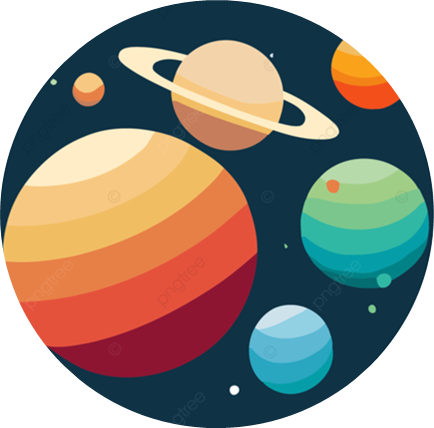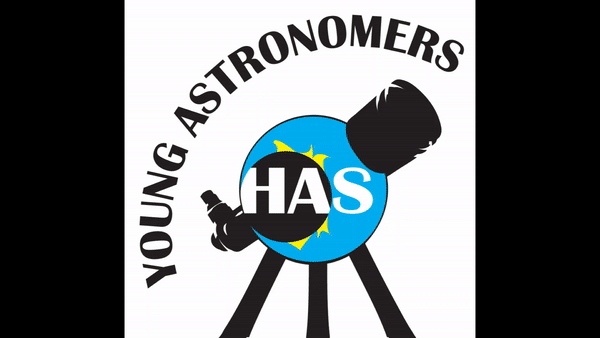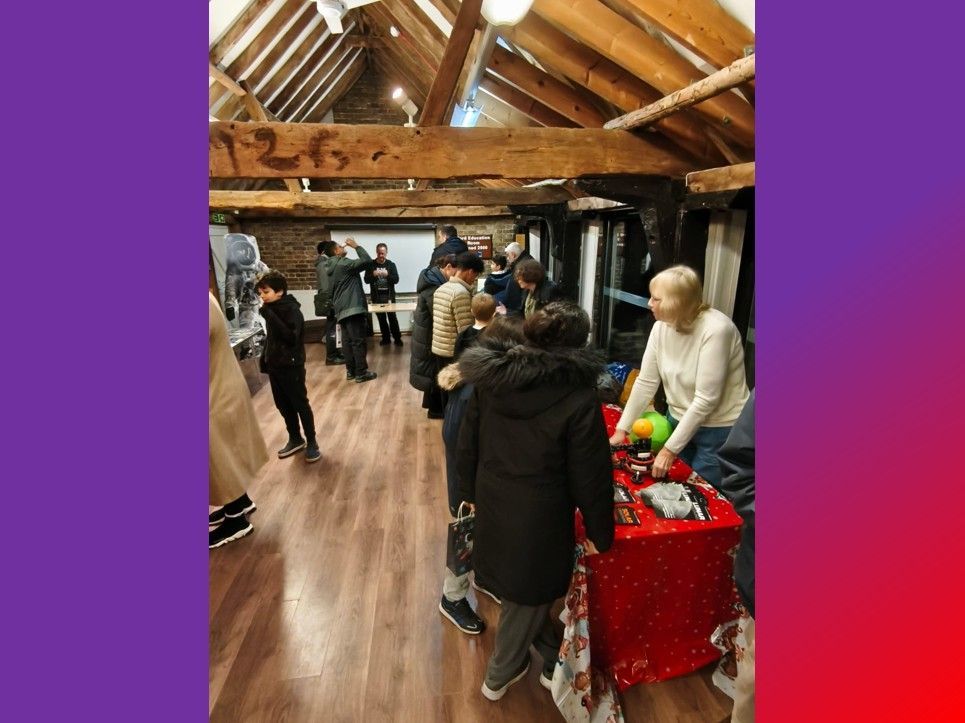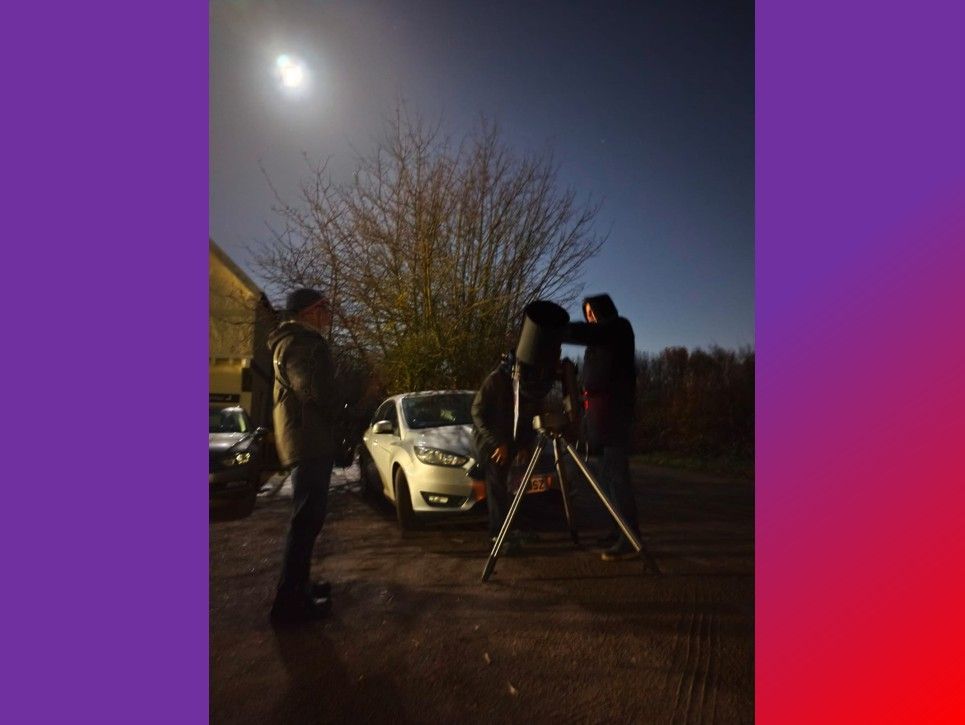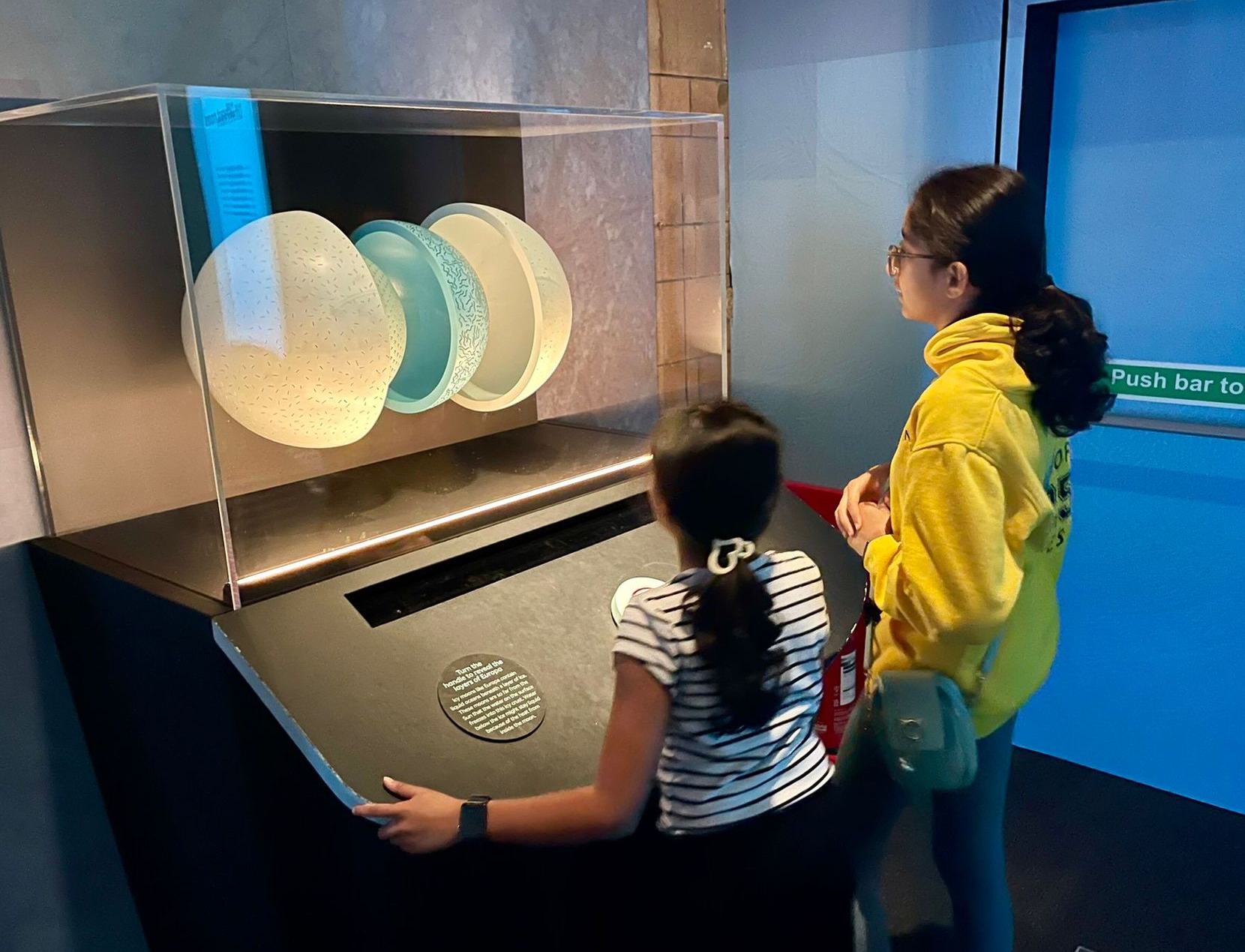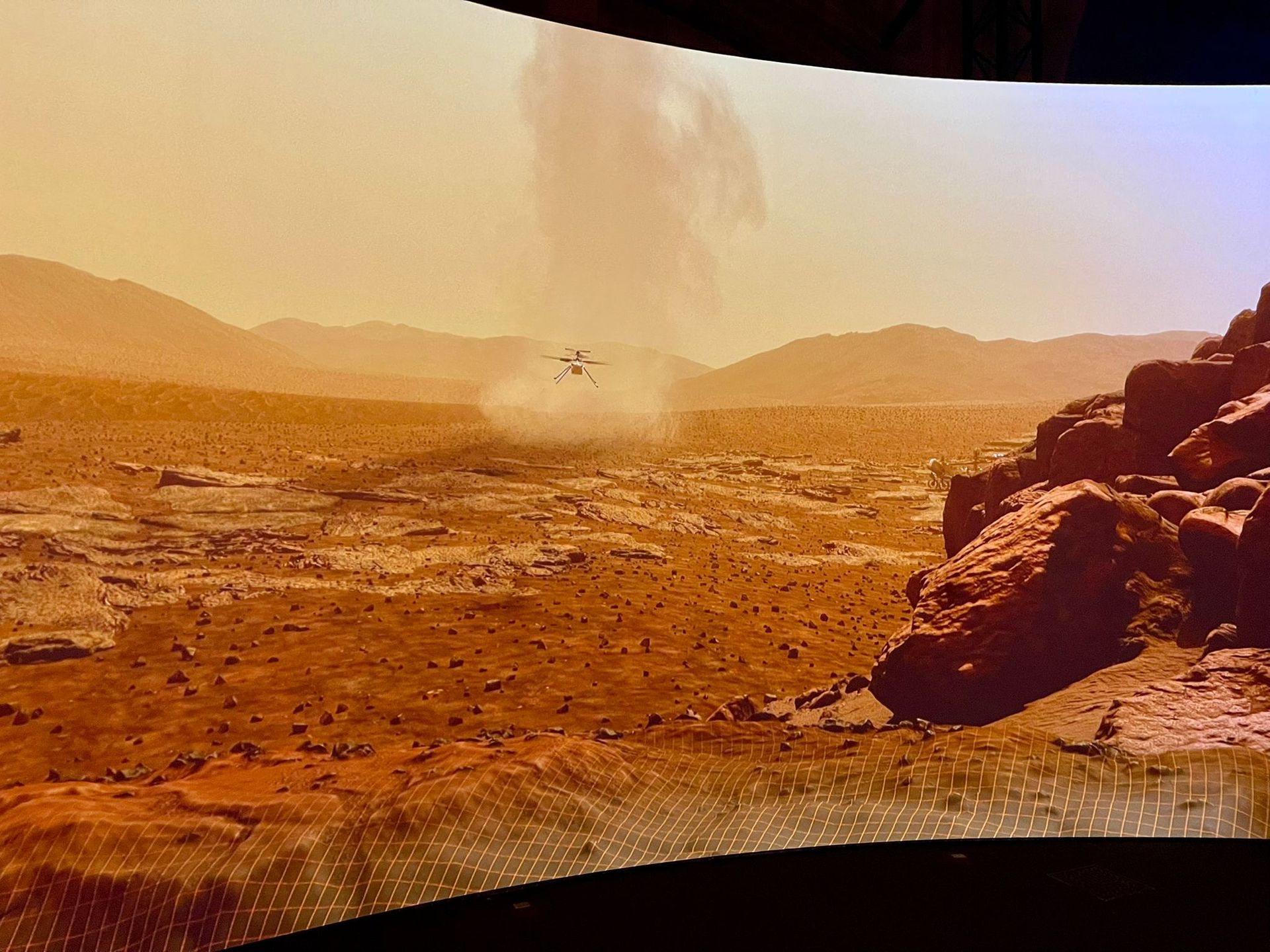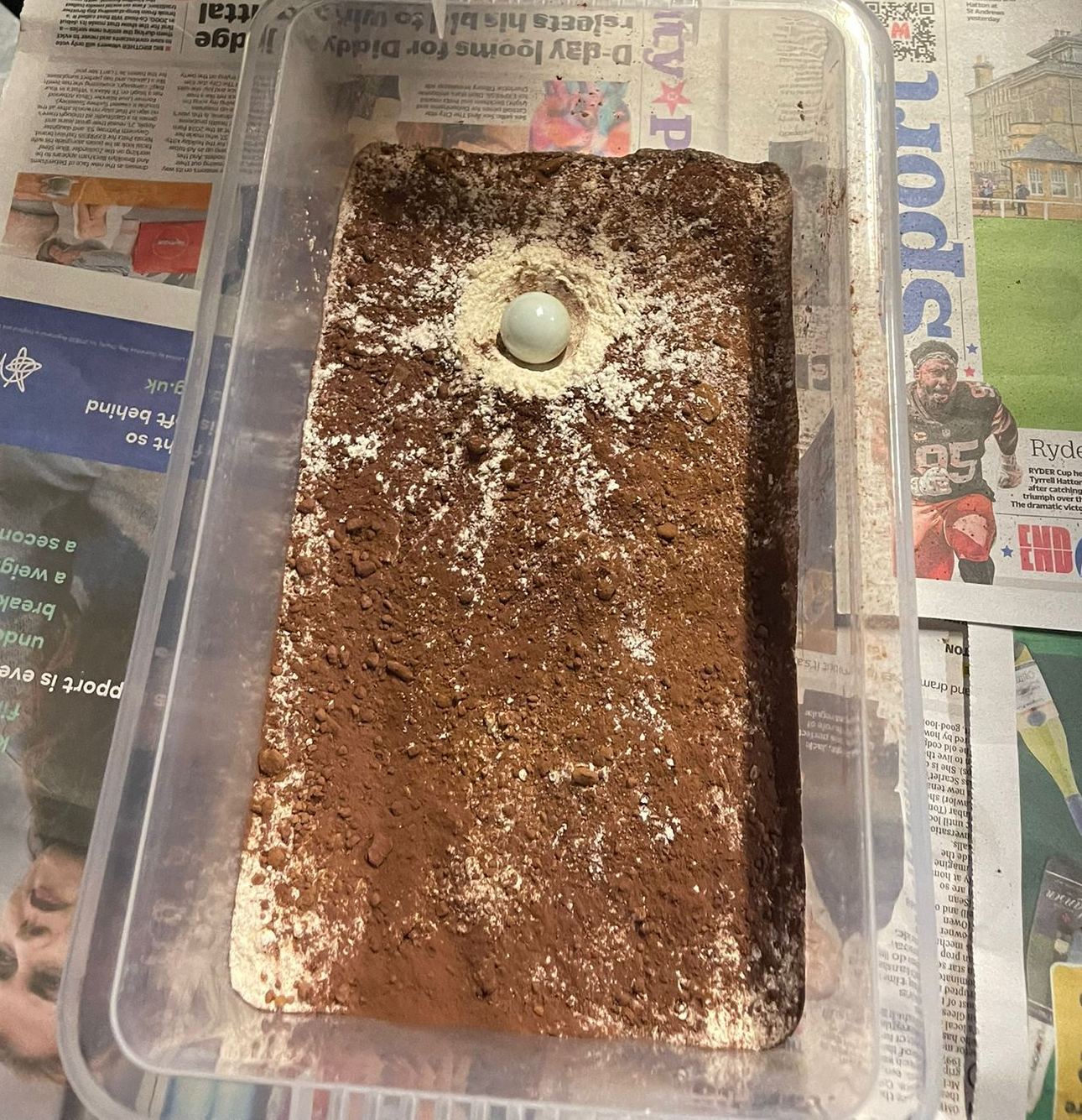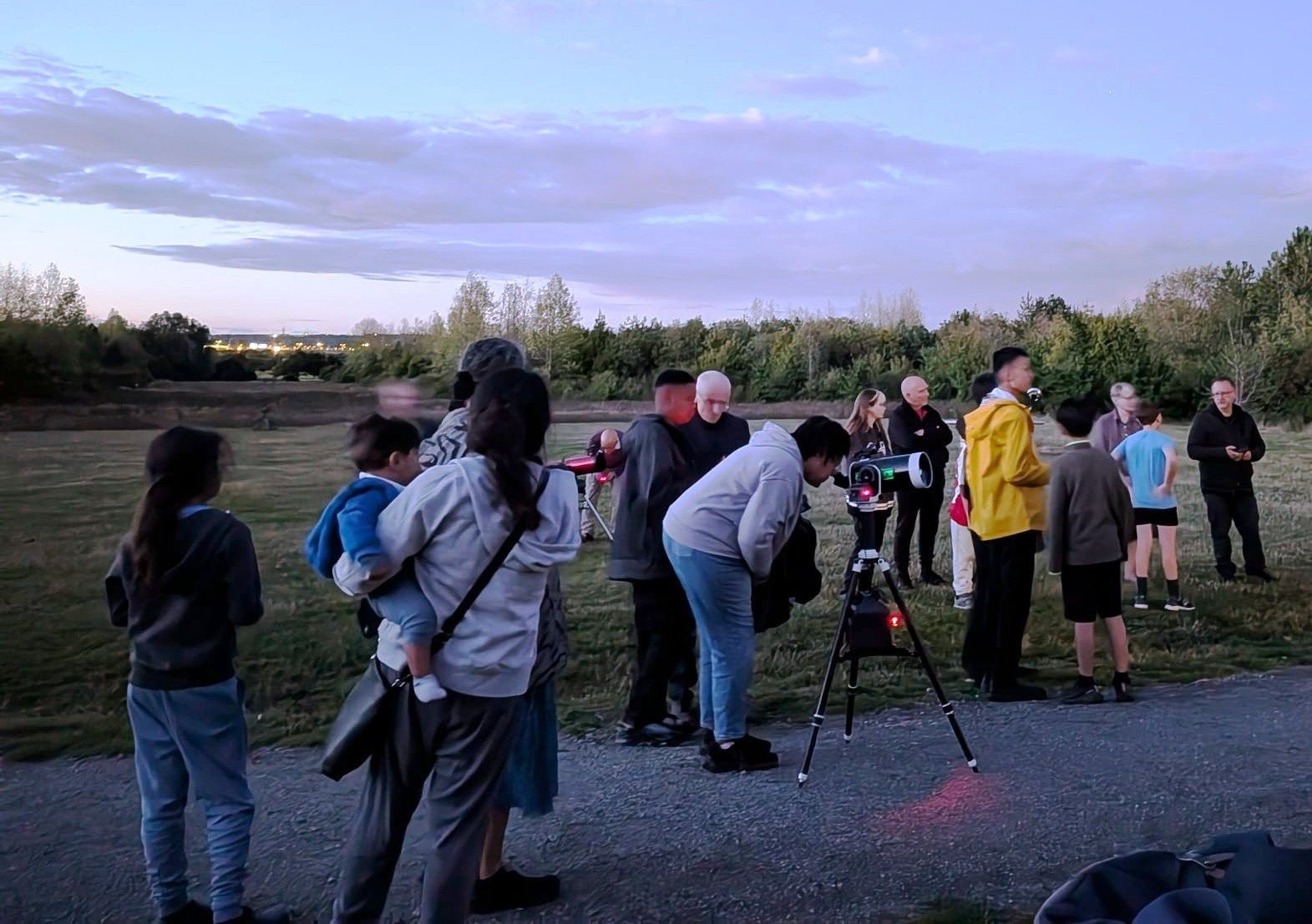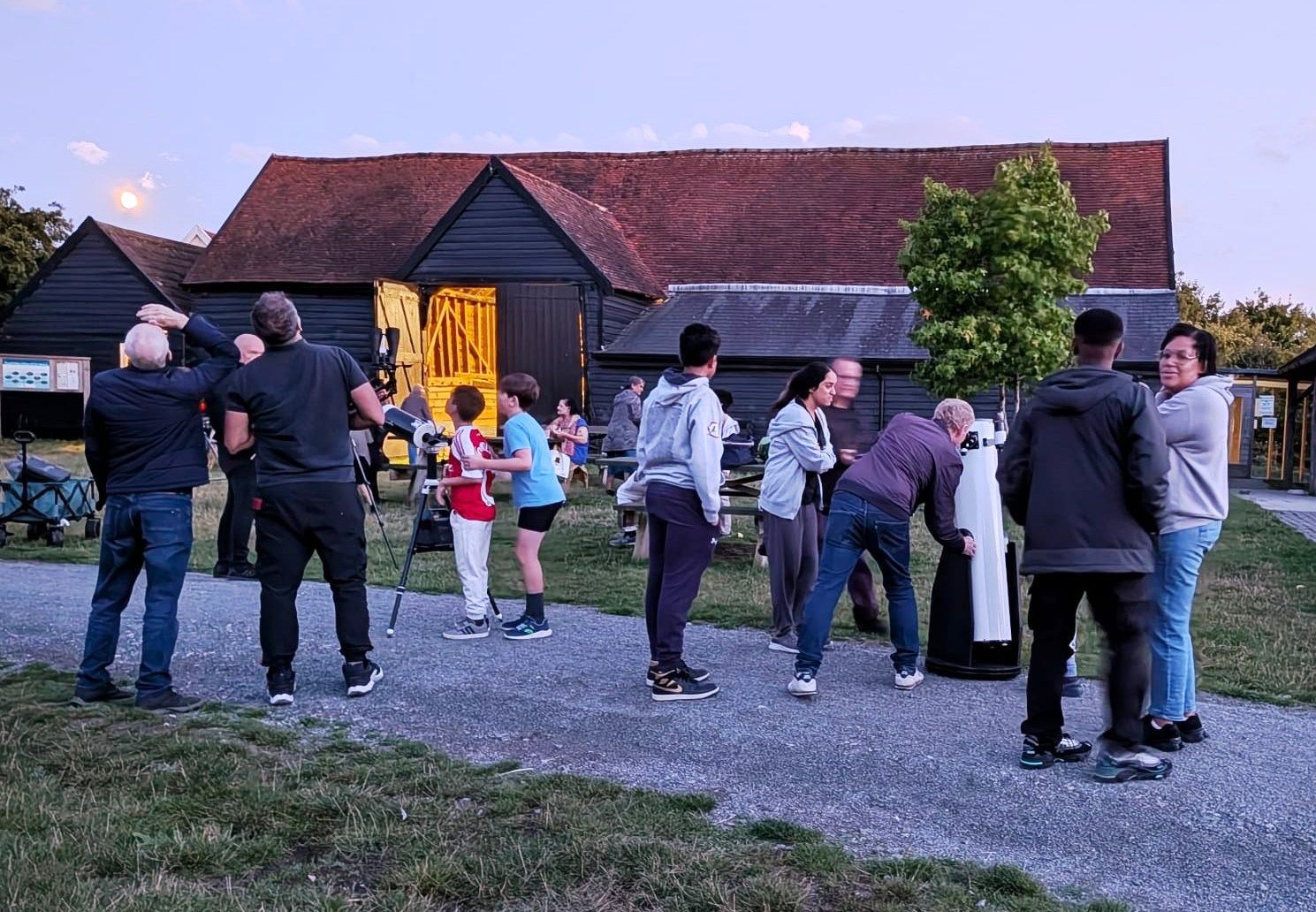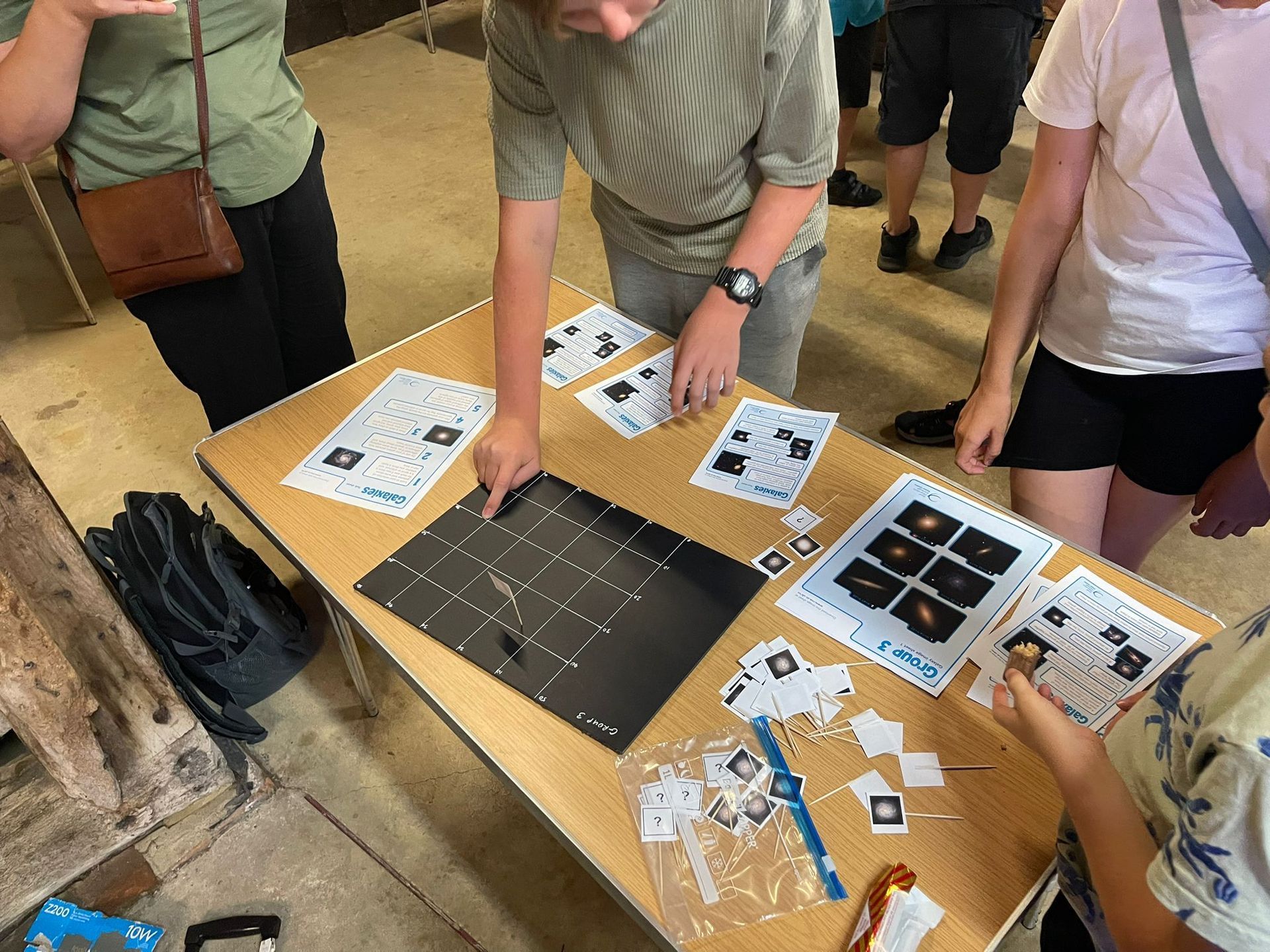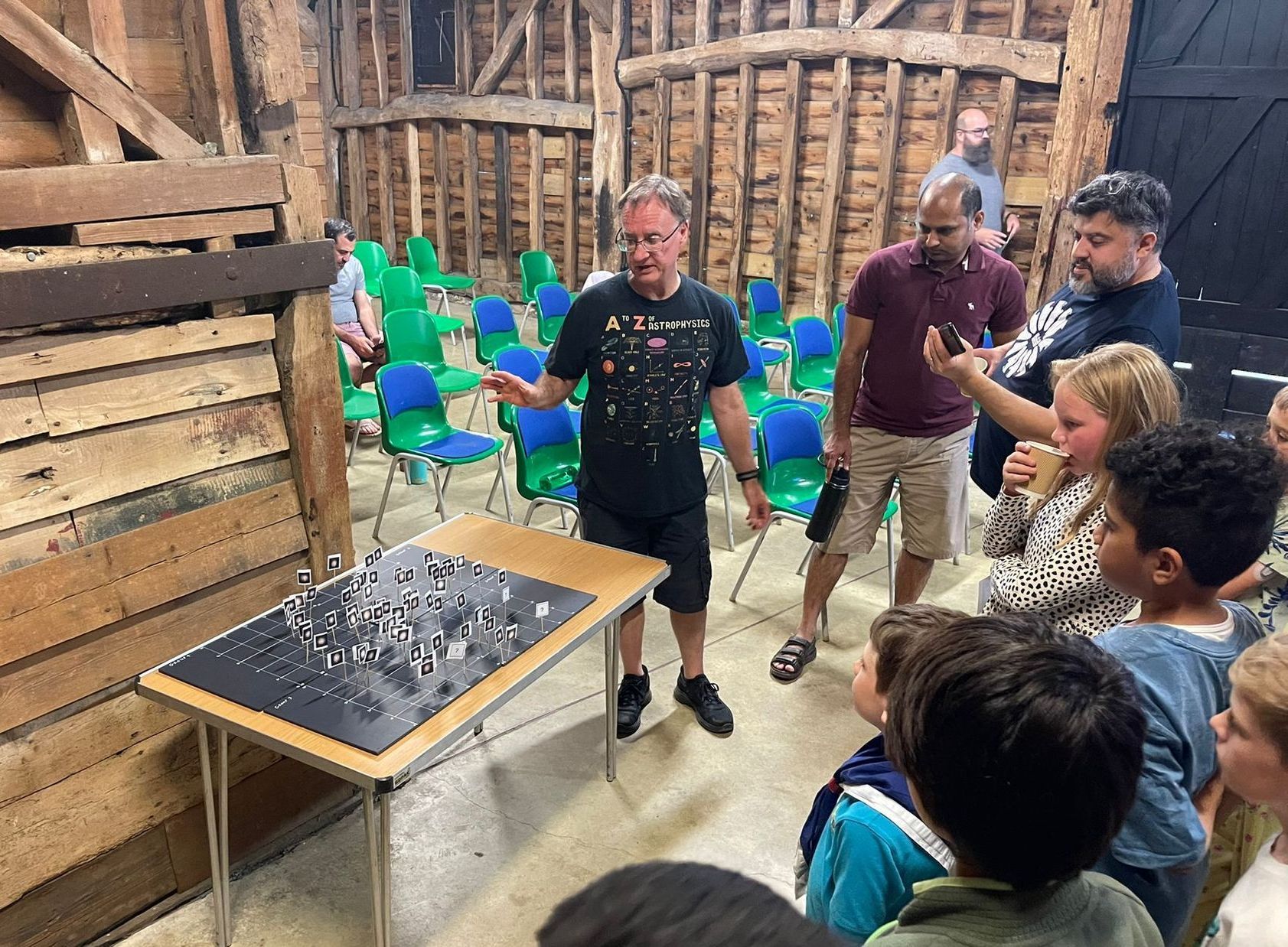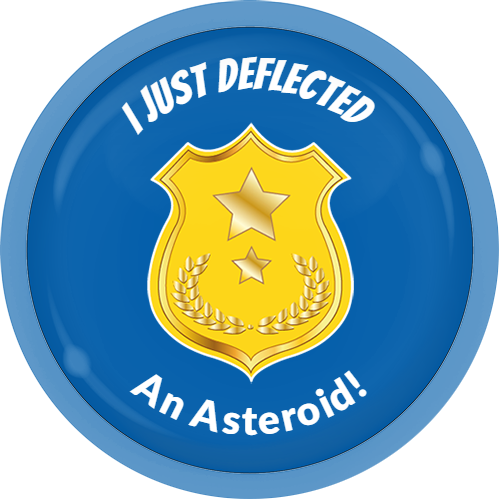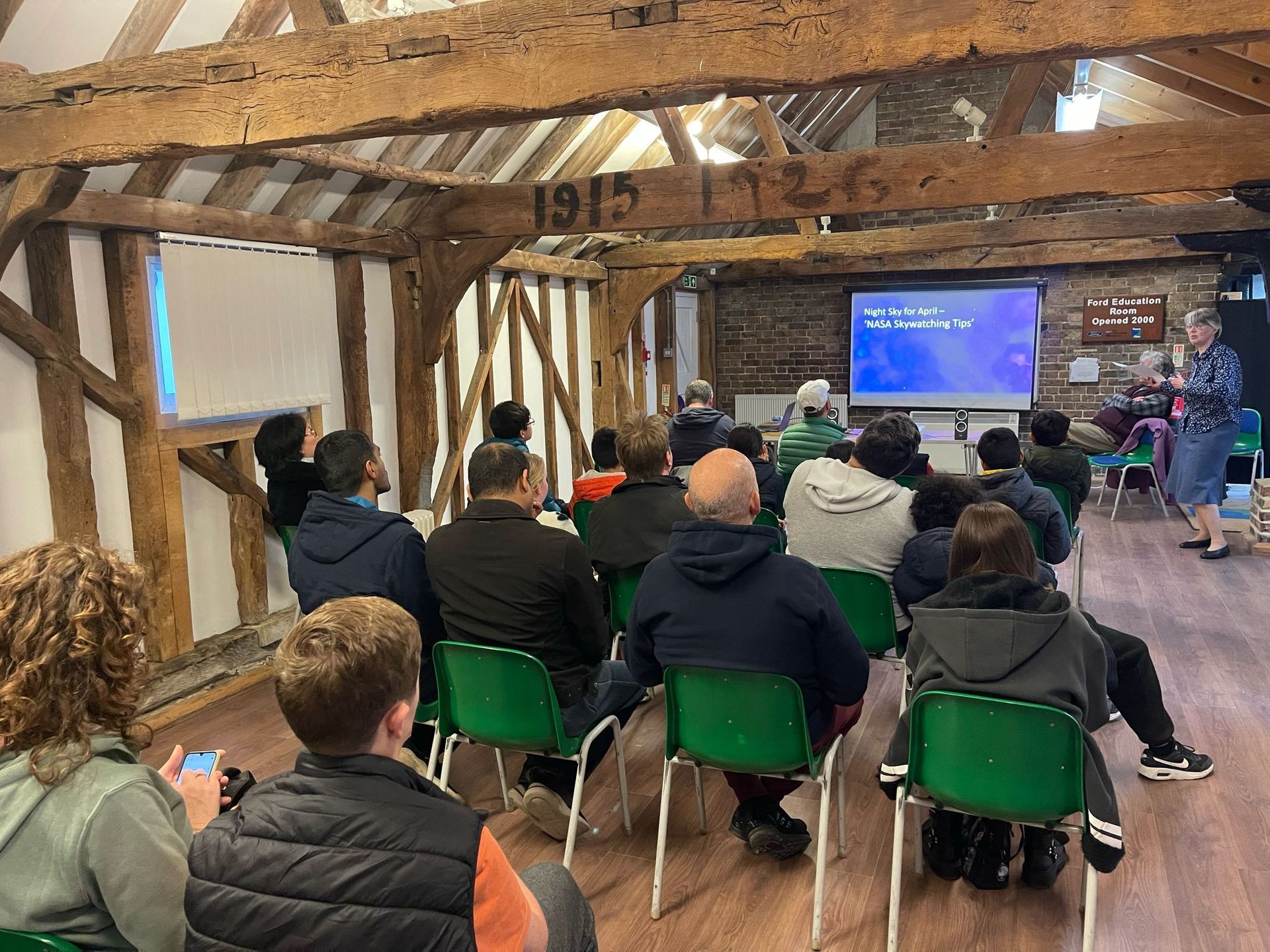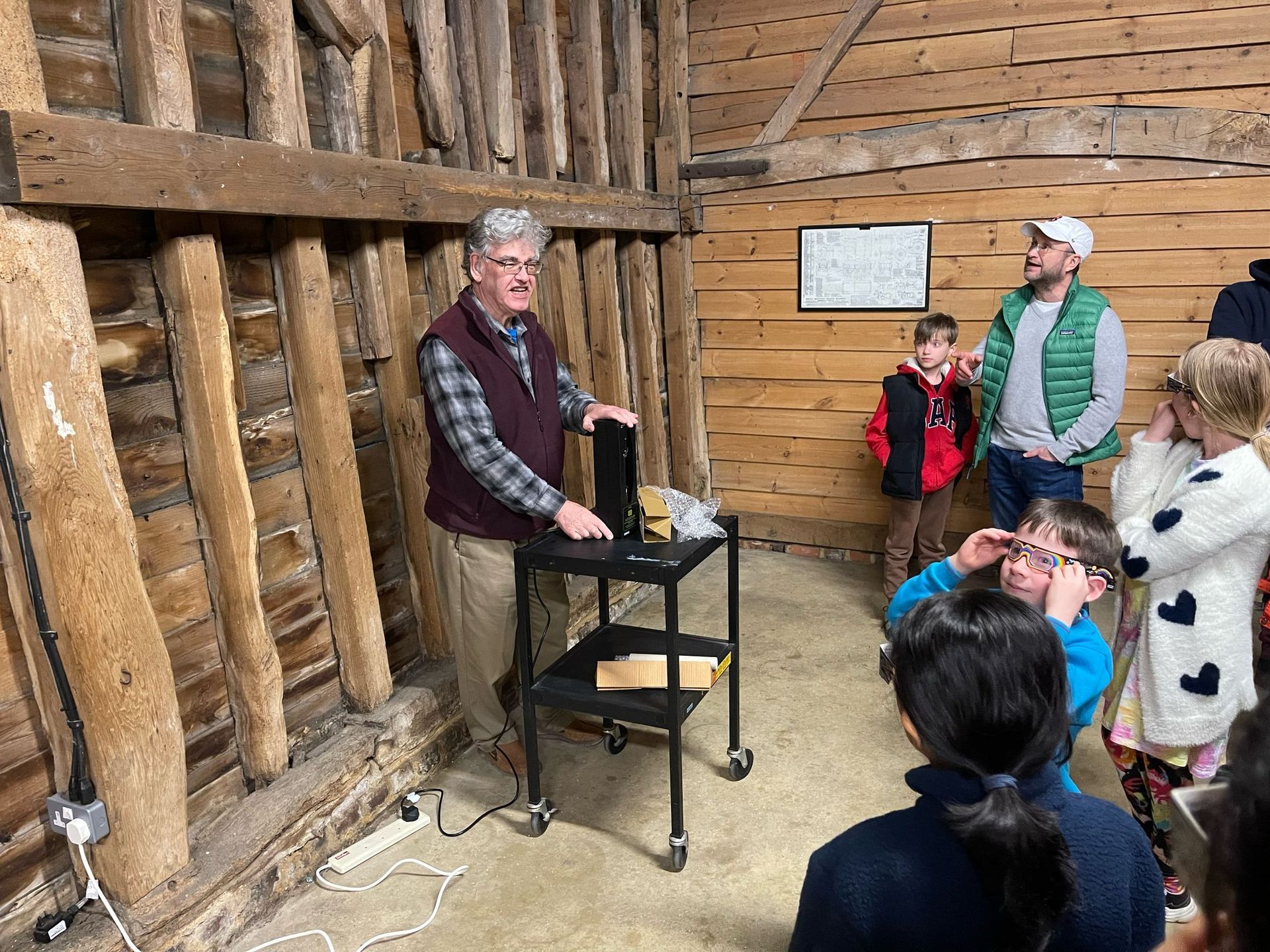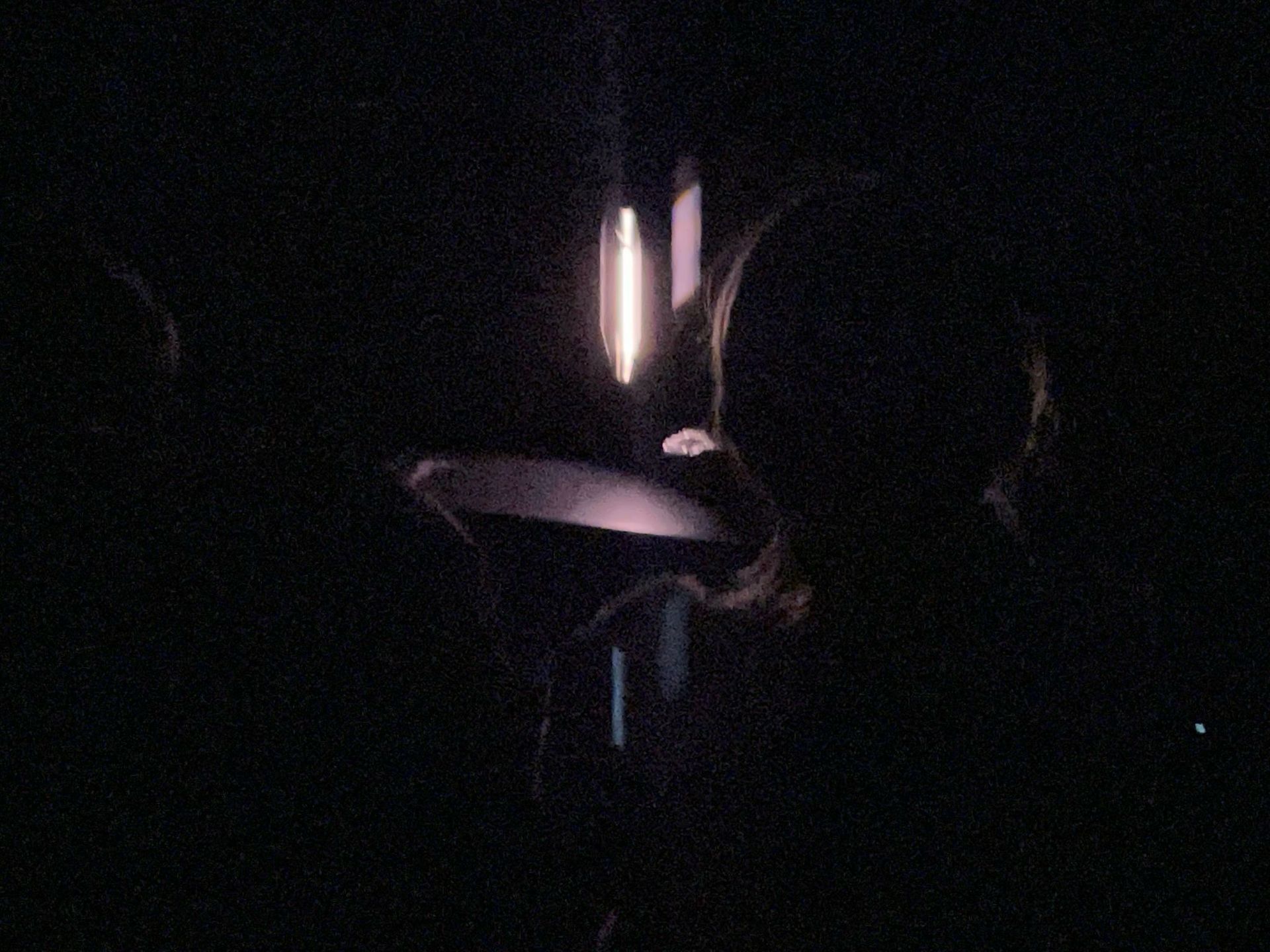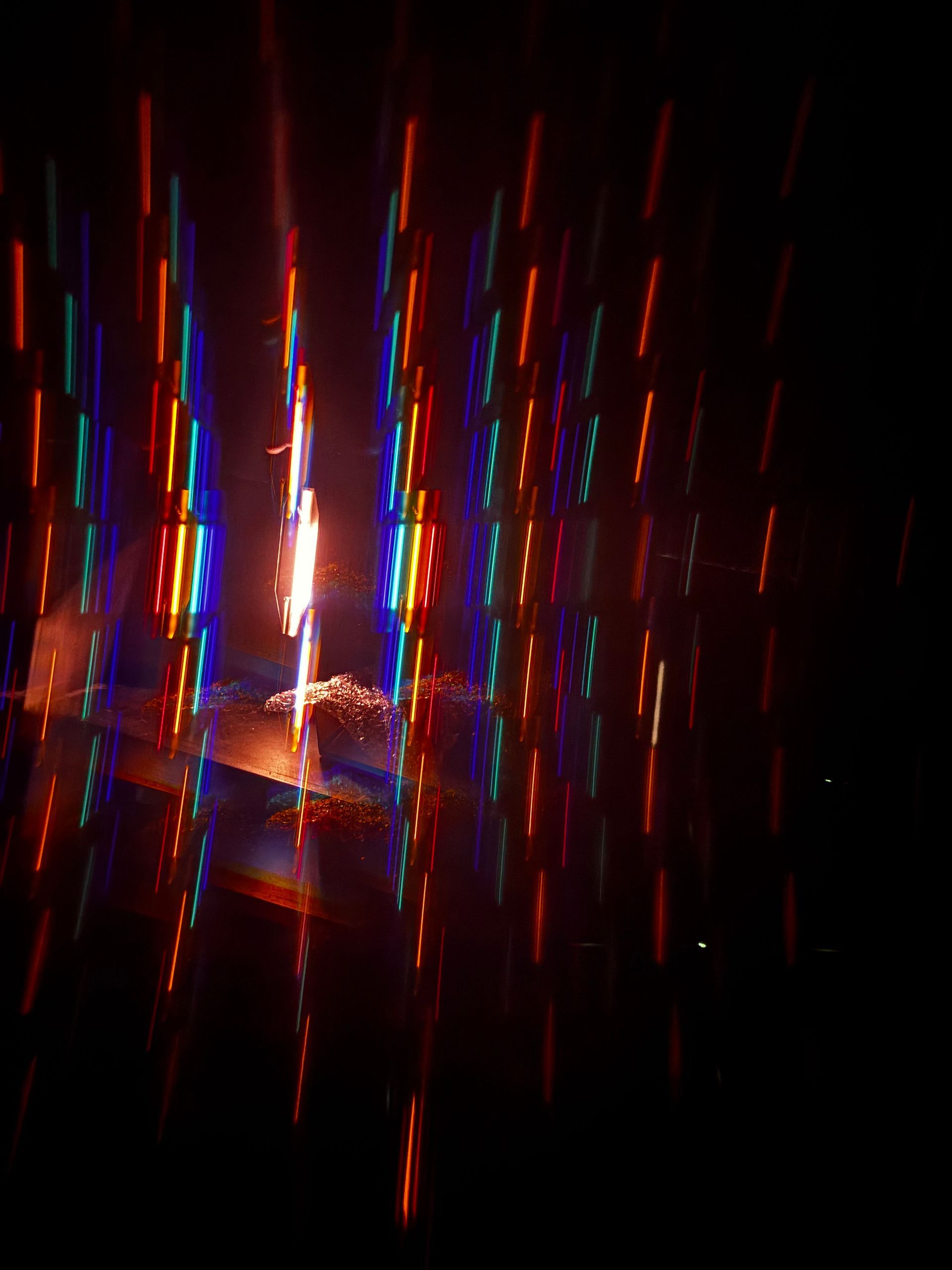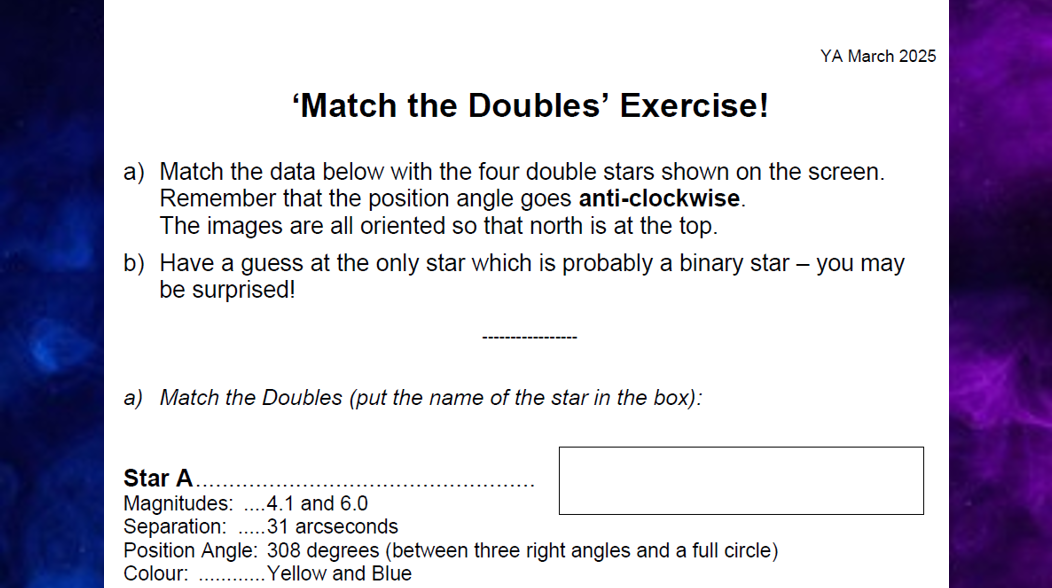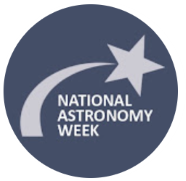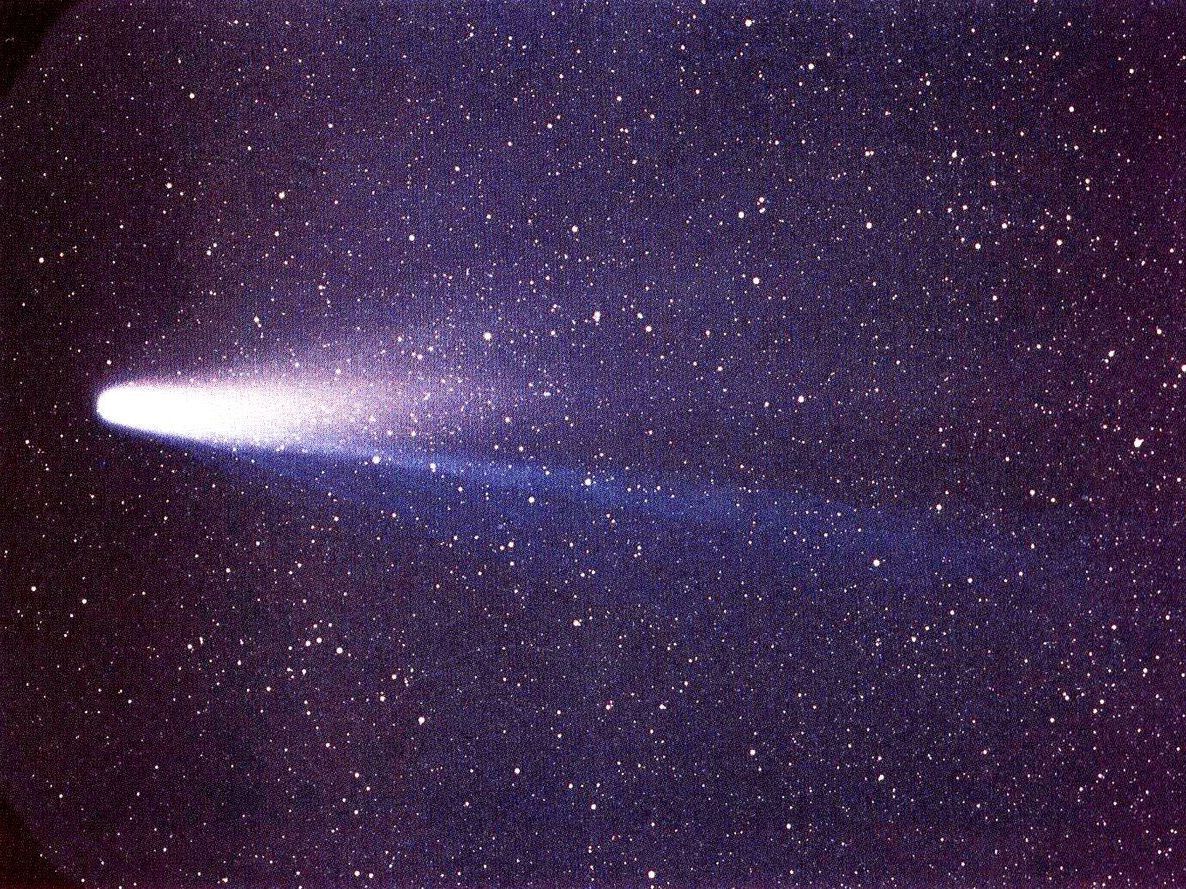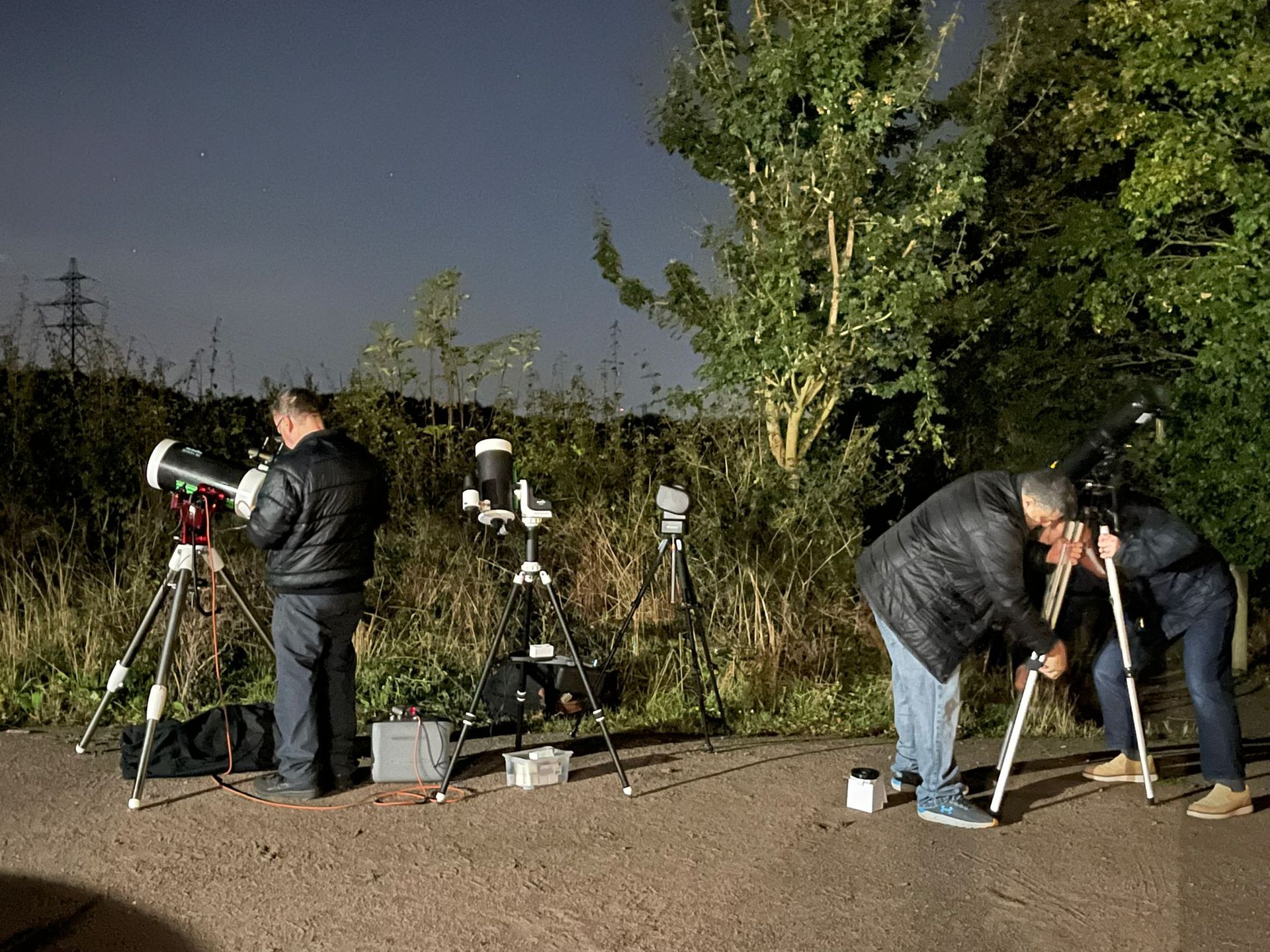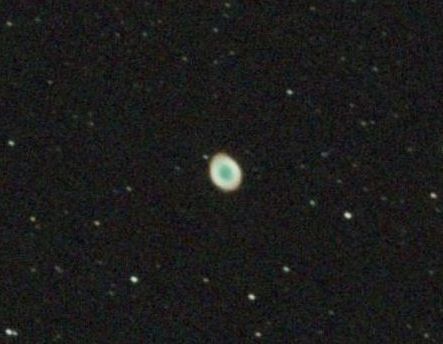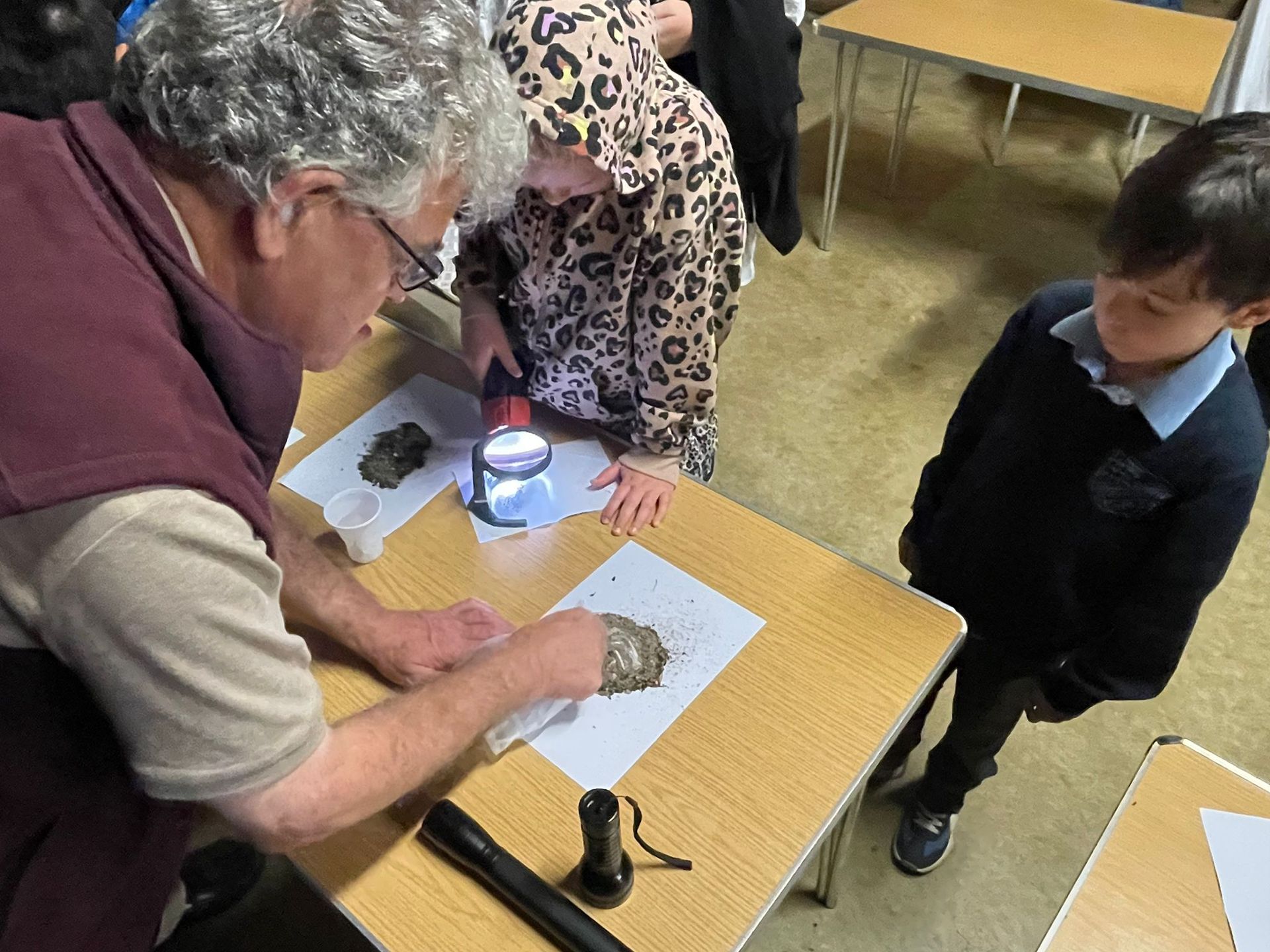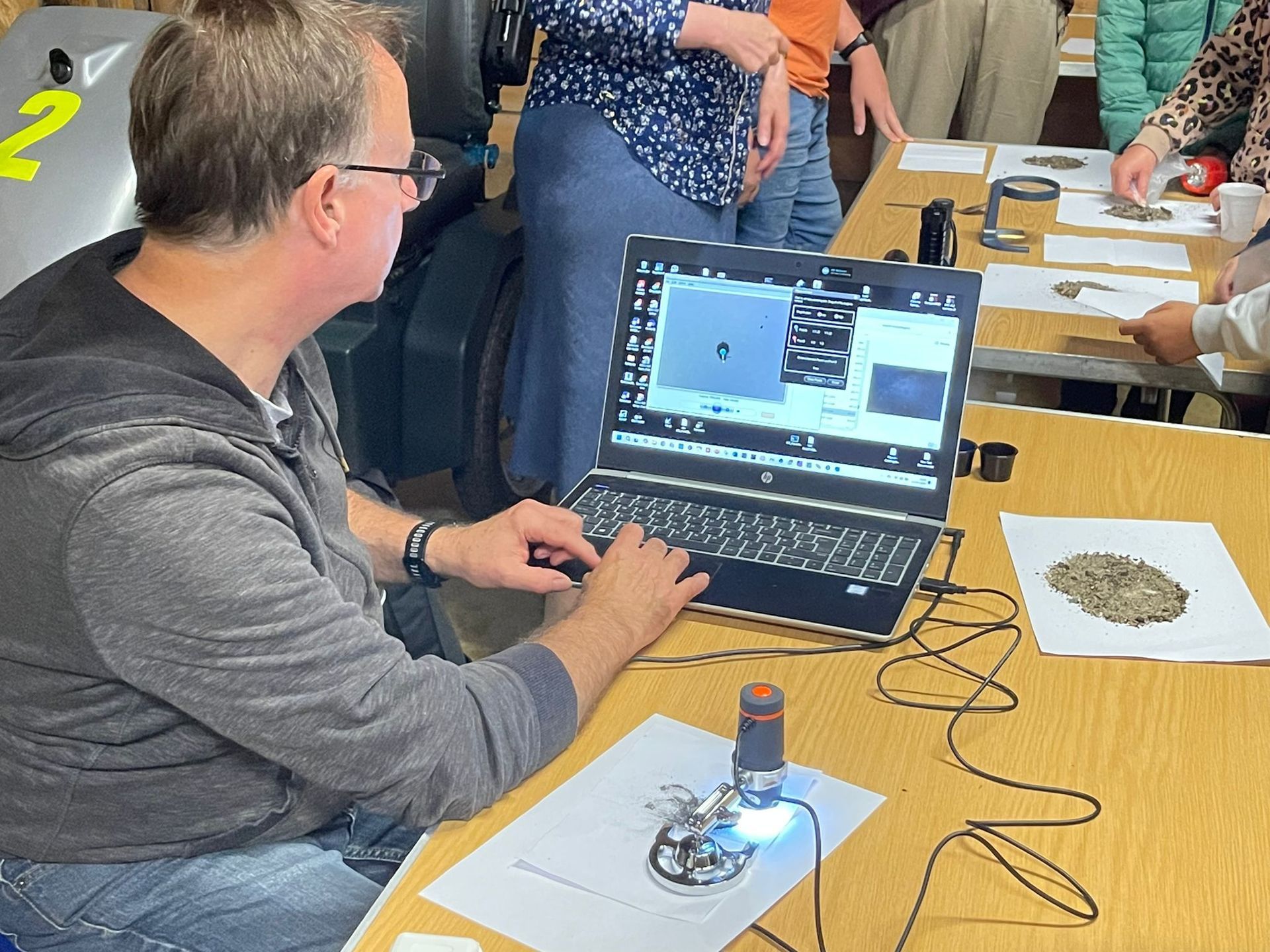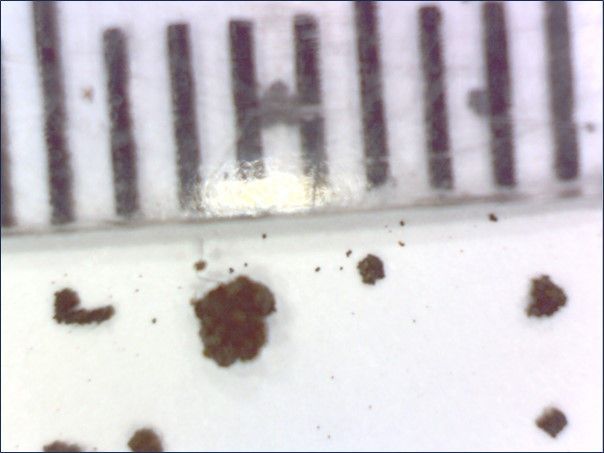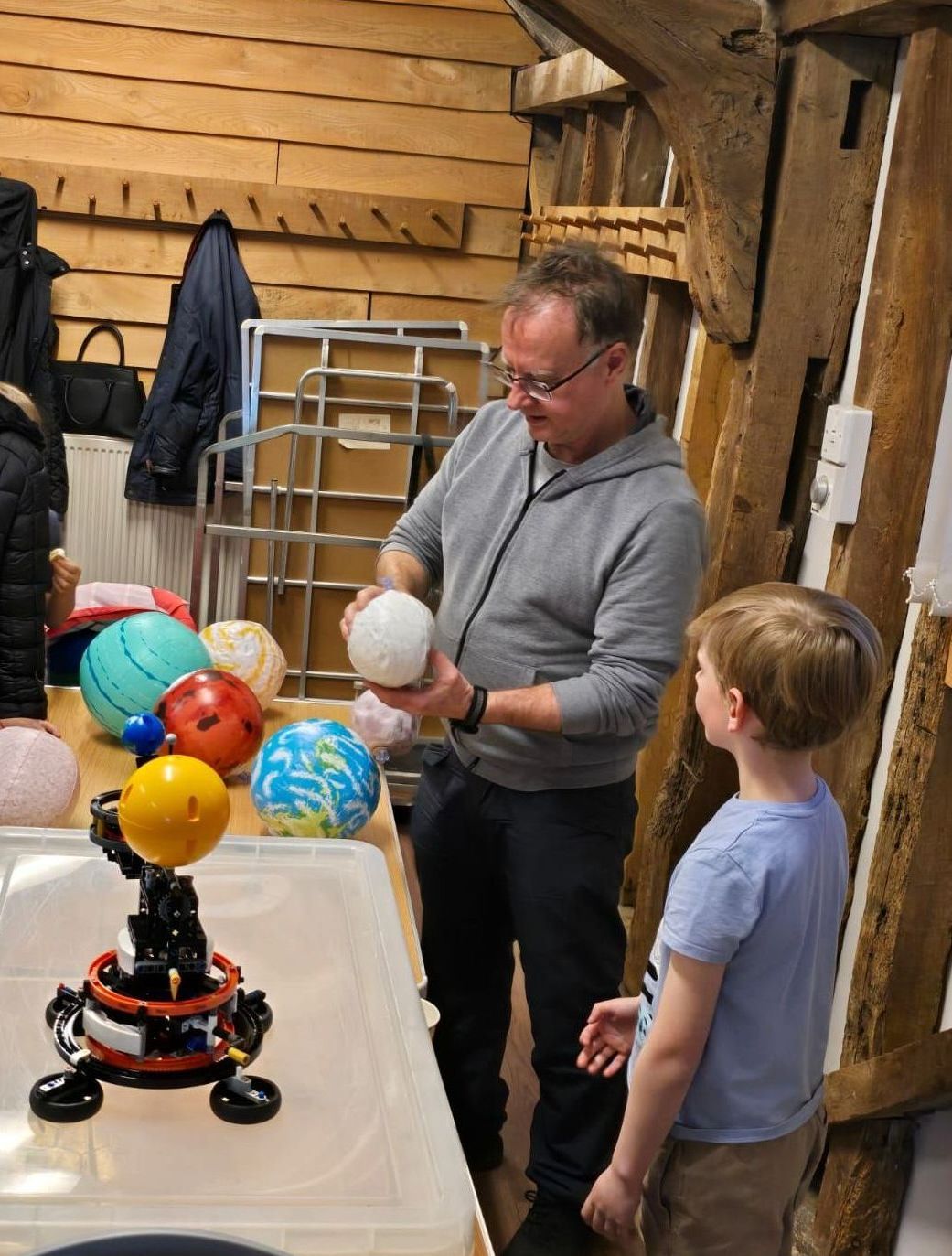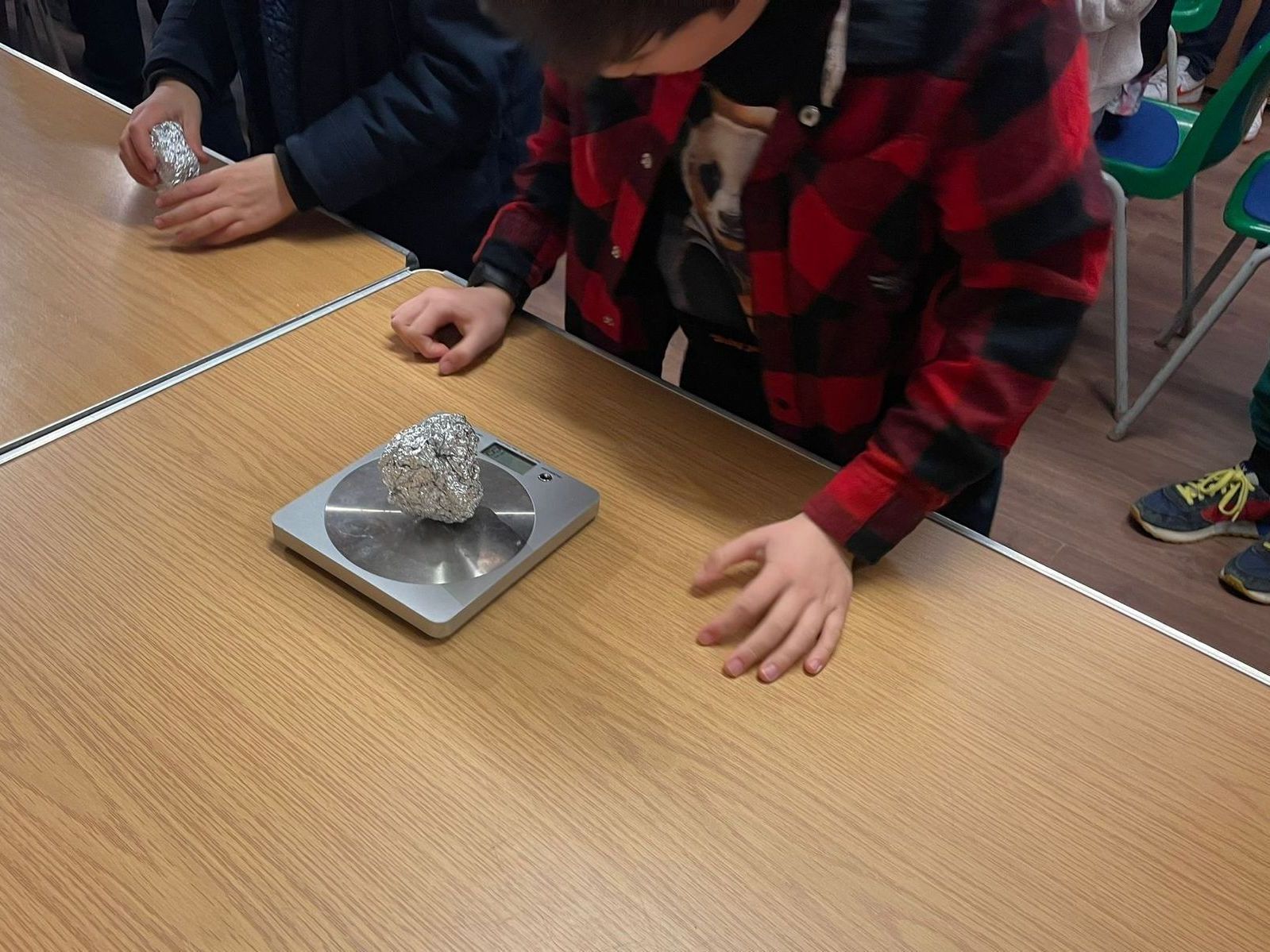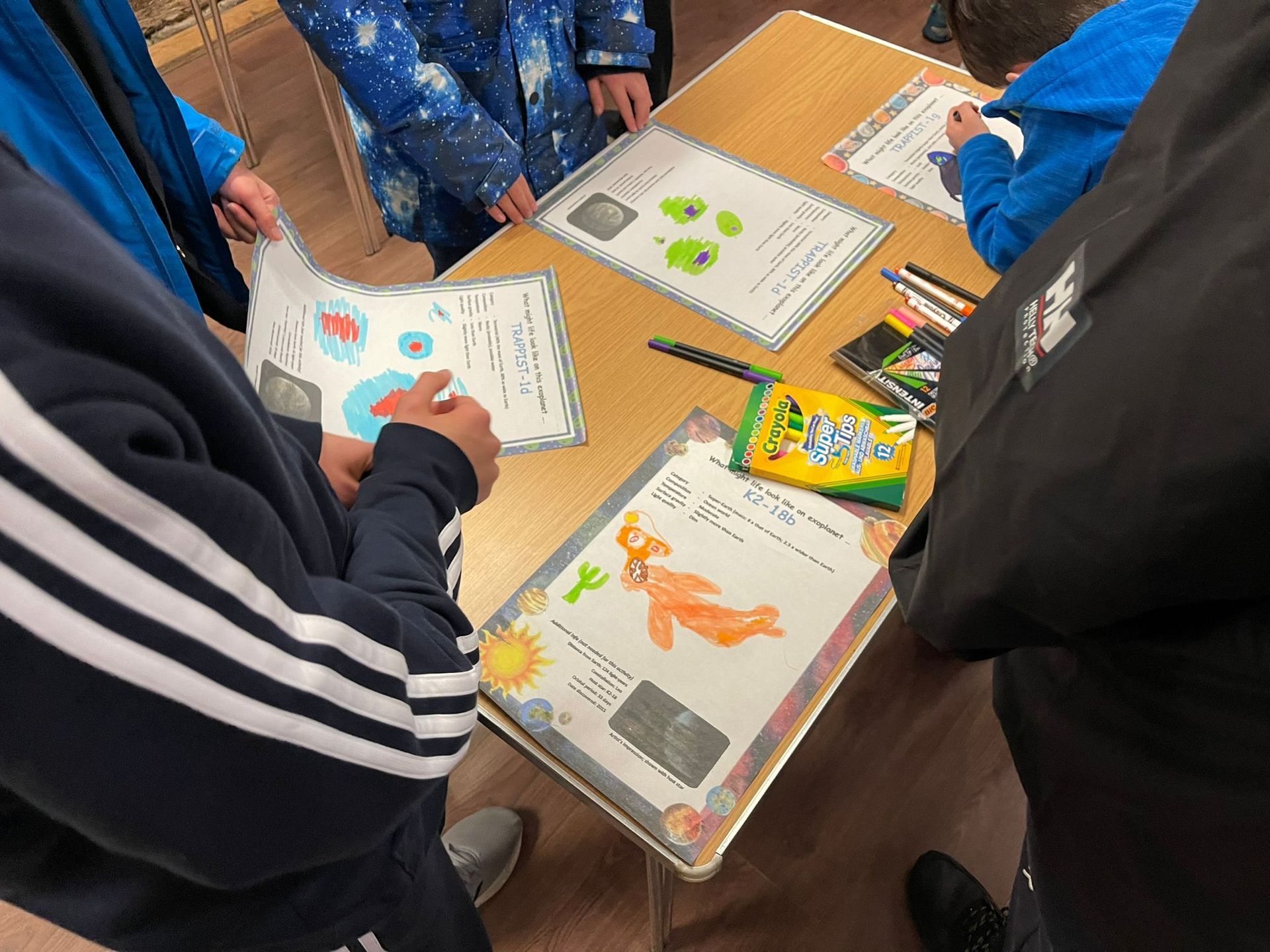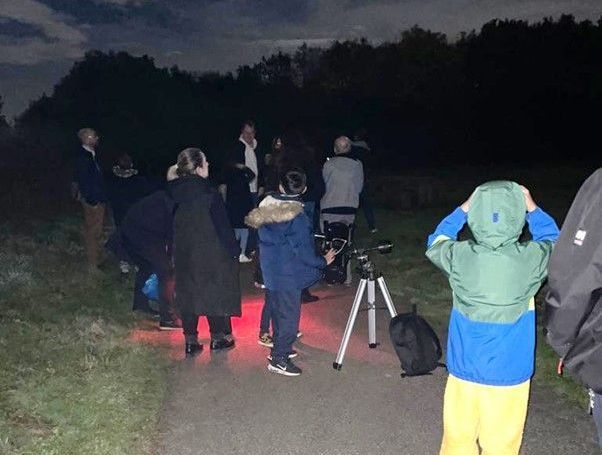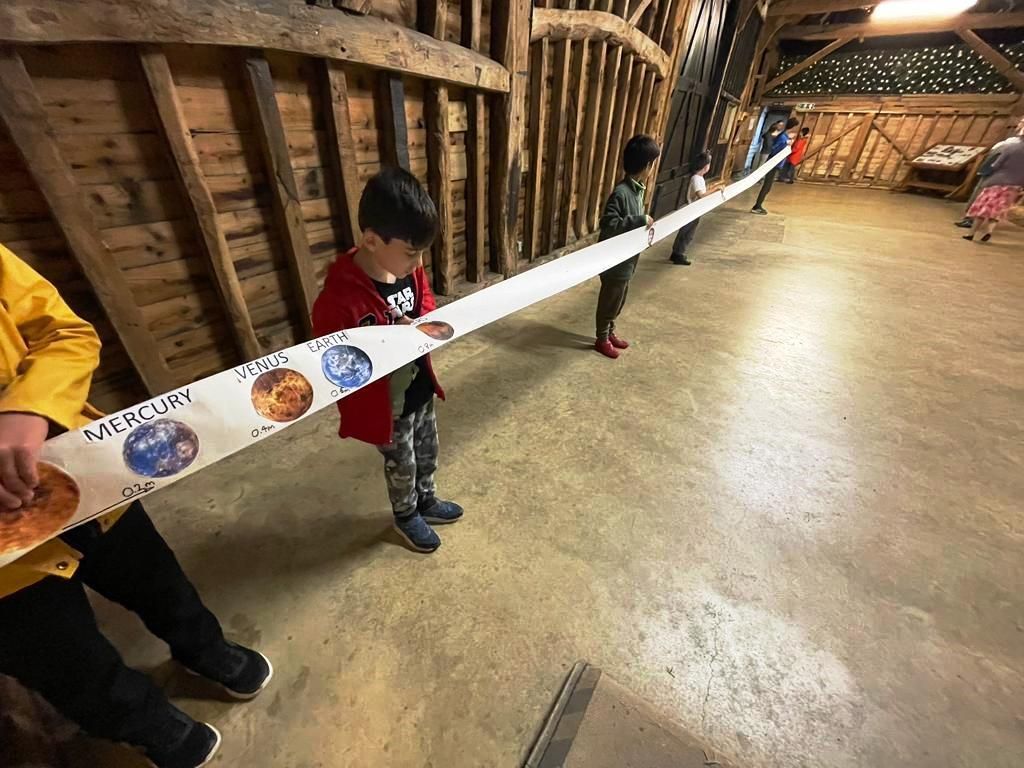HAS Young Astronomers Group:
Below are a few photos; there are more further down!
Our Young Astronomers Group was originally founded by our late Secretary Frances Ridgley, and was re-established in 2021. It provides a friendly setting for young people aged 8-16 to find out more about astronomy and make friends with other youngsters with a common interest in the subject.
The group meets at Thames Chase Forest Centre on the first Thursday of the month at 7pm (doors open at 6.45pm), and meetings usually last just over an hour. We don't meet in August. Our activities include:
- Talks by HAS members on a variety of astronomical topics, including spaceflight, the solar system, the night sky, stars, galaxies and black holes.
- Space news and what is in the night sky
- Monthly newsletter with Peter’s observing notes
- Activities to do between meetings
- The Christmas quiz at the December meeting, with nibbles
- Observing after our meetings (if it is dark and the sky is clear) and at special sessions throughout the year, including our popular Perseids meteor observing session in mid-August (weather permitting)
- Advice about buying telescopes and binoculars
- Telescope loan scheme
- An annual outing to a place of astronomical interest. In October 2022 we visited the Royal Observatory in Greenwich; and the Bayfordbury Observatory, part of the University of Hertfordshire, in November 2023. Last October (2024), we went to the National Space Centre in Leicester. This year, on Saturday 11 October, we visited the 'Space: Could Life Exist Beyond Earth?' exhibition at the Natural History Museum. These visits are made possible through the kind donation made by Ian Ridgley and family in memory of Frances Ridgley, late Society founder member and long time Society Secretary.
The group is led by Les Brand, our Outreach Officer, who works part-time as a Support Astronomer and Adult Astronomy Tutor at the Royal Observatory Greenwich, and other colleagues in the Havering Astronomical Society. For further information, please e-mail Liz Watson at
young.astronomers@havastro.co.uk.
YA meetings and activities:
info and photos from selected dates are below
December 2025 - range of activities, and Christmas refreshments
For our December meeting, we had a number of space-themed activities and displays; clockwise round the room from the registration desk, these were as follows:
- making space-themed Christmas cards
- making ‘constellation lights’ (constellations punched into cardboard cups, lit up by an electronic candle inside)
- trying to escape the gravity well around a “black hole” using straws
- a display about the Moon and the Apollo landing sites; with a cut-out figure of Buzz Aldrin close by, in case anyone wanted to take a selfie
- spectroscope-making, using gratings and cardboard tubes
- making impact craters
- demonstrating solar and lunar eclipses using a tellurion
- making paper rockets with two templates, propelled using straws.
Each activity, apart from the Christmas card, had information sheet(s) to go with it.
Also, one of our YAs, named Zain, explained and demonstrated his own astro simulations on his laptop.
We had clear skies, so the YAs were able to do some observing, with volunteer Jack Martin providing a spectroscope so they could see the spectrum of the bright star Vega; and two telescopes provided by our Chair, Les Jones.
The YAs received goody bags, containing a range of space-related leaflets, eclipse-viewing glasses and small red lights (useful for observing), kindly provided by First Light Optics; and there was also the chance to pick up astronomy books free of charge, brought in by Les Jones.
We also had some festive refreshments. Many thanks to our committee members and other volunteers who helped make the evening a great success; also heartfelt thanks to all who took photos.
Credits: Liz Watson - #1, 2 , 4; Sophia Yan - 3, 5-9; Emma Christmas - 6; Les Brand - 6; Jack Martin - 11
November 2025 - history and development of the Milky Way, part 2, followed by Q&A
The evening was hosted by Les Brand, and opened with some photos of the 11 October YA trip to the ‘Space: Could Life Exist Beyond Earth?’ exhibition at the Natural History Museum (details below). We also showed a short video about the November night sky, produced by the National Science Centre in Leicester, and updates on three comets which have been making the news (SWAN, Lemmon and the interstellar visitor ATLAS).
Les then showed the second half of the BBC Brian Cox’s ‘Universe’ series 1, episode 3: ‘The Milky Way: Island of Light’ (we saw the first half in September; details further below). This was preceded by a short video by Dr Sheona Urquhart, one of the series' consultants, about working on the series and exploring the Milky Way. As mentioned below, this programme explored the history of the Milky Way, its collisions with other galaxies, and the secrets revealed by the Gaia Space Telescope. Les was an advisor for this episode and is credited at the end.
BBC iPlayer link to the programme (it can also be found on Youtube):
Image credits: #1, 2 and 4 - Les Brand; #3 - ESA
ANNUAL TRIP: Visit to the 'Space: Could Life Exist Beyond Earth?' exhibition,
Natural History Museum, London -11 October 2025

An enjoyable and educational visit to the above exhibition, organised by Les Jones, with a good turnout of Young Astronomers and their parents/guardians.

The exhibition explores the Big Question – are we alone in the Universe? As the Museum puts it: “Touch a piece of Mars, wrap your hands around a fragment of the Moon and snap a selfie with the Allende meteorite, which – at 4.567 billion years old – is even older than Earth!” and “Travel from Earth’s extreme environments out into space, stopping off at asteroids, Mars, the icy moons of Jupiter and Saturn and planets beyond our solar system in the search for life.”
Helping them to answer this Big Question, the Young Astronomers saw some carefully curated displays and models relating to the Solar System, asteroids and exploration missions - many of which have featured in the news - and interacted with a range of exciting activities.
This visit was made possible through the kind donation made by Ian Ridgley and family in memory of Frances Ridgley, late Society founder member and long time Society Secretary.
Our grateful thanks to our Chair, Les Jones, for organising this event.
Further information:
The exhibition is running at the Natural History Museum in London until 22 February 2026.
* (Fig. 4) - info about the OSIRIS-REx mission: https://science.nasa.gov/mission/osiris-rex/
Photo credits: #1, 6 - Liz Watson ; #2-5, 7-8 - Les Jones
October 2025 - the Moon (talk and crater activity)
Les Brand marked NASA’s then-upcoming [4 October] Observe the Moon night with a talk about the Moon – its dimensions, rotation period and topography, including craters, maria (Latin for ‘seas’; impact craters filled with basaltic lava from ancient volcanoes) and rilles (narrow channels or depressions). We also saw a short video on how the Moon is currently thought to have been formed (from a collision between the Earth and the hypothetical Mars-size planetary body Thea; the latter was destroyed in the impact, but debris from the collision later coalesced to form the Moon).
Using the interactive website LROC QuickMap,* Les demonstrated the drawing of surface relief profiles for the impact crater Copernicus (about 58 miles across) and Rupes Recta, a linear fault about 110-130 miles long. We also saw an image of the crater Tycho, and its pale but vibrant 'ejecta' – rays created by dust and debris blasted outwards when a body such as an asteroid hits the surface.
* A powerful map interface for browsing lunar data in 2D and 3D from NASA/LRO [Lunar Reconnaissance Orbiter] and other missions.
As it was cloudy, we had an indoor activity after the break. This involved making craters by dropping objects (representing asteroids) such as marbles, small stones and conkers into trays of flour covered with a contrasting thin layer of cocoa; the cocoa representing the lunar surface. These impacts revealed the pale surface under the brown ‘cocoa’ surface, and created ‘ejecta’ rays. The YAs experimented with different sized stones, heights and angles to see the various craters and ejecta that could be created. We also had some rulers handy to measure width and depth of the craters.
Photo credits: #1-3 by Les Jones
September 2025 - history and development of the Milky Way, followed by observing
The evening was hosted by Les Brand, and opened with some info on the 11 October YA trip to the ‘Space: Could Life Exist Beyond Earth?’ exhibition at the Natural History Museum (tickets for YAs are funded by Ian Ridgley and family’s generous annual donation in memory of Frances Ridgley). We also saw some photos and Les’ timelapse video from the 14 August Perseids watch evening, plus a short video by NASA about the September night sky (these can be viewed here: https://science.nasa.gov/skywatching/whats-up/ and on Youtube).
Les then showed, as a follow-up to his talk on galaxies in July, the first half of the BBC Brian Cox’s ‘Universe’ series 1, episode 3: ‘The Milky Way: Island of Light’. This explored the history of the Milky Way, its collisions with other galaxies, and the secrets revealed by the Gaia Space Telescope. Les was an advisor for this episode and is credited at the end. BBC iPlayer link to the programme (it can also be found on Youtube):
After the break, we went out to do some observing. The YAs were very enthusiastic, and were able to observe targets such as Vega, the Double Double and the Moon!
Many thanks, as always, to those who brought observing equipment (Les Brand, Martin Gill, Les Jones, and Ian and Jacqui Moss), and others who participated in any way; including those who took photos on the evening.
Photo credits: #1, 2, 4 and 5: Jacqui Moss; #3: Les Jones
July 2025 - talk and activity regarding Galaxies
Les Brand gave a talk about galaxies: explaining what they are composed of, and describing the different types such as spiral galaxies like our own Milky Way, and elliptical ones. He went on to talk about how small galaxies might have around 10 million stars, while larger ones may have trillions. He explained that galaxies are often found grouped together in clusters of 50-1000; also that their colour can indicate the age of the stars within it; those which appear blue contain young hotter stars, while those which appear red contain older cooler stars.
After the break, Les gave the YAs an activity which required them to look at a number of images of galaxies and to decide whether they were spiral or elliptical; or to indicate if they were unable to decide. They were then asked to plot the positions of these galaxies on a grid using flags showing the different galaxy types, or a question mark if they were undecided. The YAs were divided into four groups, each with a different set of images and grids. Once they had all completed their individual grids, these were placed together to form one whole cluster. Les then talked about what the groupings of the particular galaxies in the cluster might mean.
- Photo credits, #1, 2, 5 and 6: Les Jones; #3: Beryl Patient; #4: Les Brand; #7: Emma Christmas
June 2025 - talk and activity regarding Asteroids
Les Jones presented a talk about asteroids: what and where they are, where they come from, and how we can learn more about them (including a look at several fly-by and sample-return missions).
We also heard about their impact (literally!) on Earth, and how we can defend our planet against them. There are several proposals for deflecting asteroids, and the DART Mission in 2023 tested the 'kinetic' method of crashing a spacecraft onto the surface of a small asteroid orbiting another one, in order to alter its path.
After the break, we had an activity. Firstly, Peter showed that near-Earth asteroids are really small compared with the Earth. Using a basketball to represent our planet, and a tennis ball the Moon (the relative sizes are more or less correct), he showed that an asteroid would be about the size of a grain of salt – yet still able to cause a major upheaval if it hit the Earth. He then showed in the barn that the Moon would be 25 feet away from the Earth on this scale. So, if you hear that an asteroid is flying between the Earth and the Moon, it is still a long way from us and not a hazard.
The gif in image #1 illustrates the activity, which involved saving Earth from an asteroid, using the kinetic method. This involved kicking a blue (or other coloured) ball to nudge a red ball (representing an asteroid) away from Earth. It is harder than it looks, and it took some YAs a few goes! On their successful defence of Earth, they were awarded an 'I just deflected an asteroid' badge.
- Credits, #1 (gif): Magda Wheatley; photos #2, 3 and 4: Les Jones
May 2025 - talk and activity regarding Mars, 'then and now'
Les Jones gave a talk entitled 'Mars, the Red Planet - or was it once blue?'. It is now a cold, arid world, dominated (and sometimes obscured) by dust storms; though also with polar ice caps which expand and contract with the seasons. However, scientists think that Mars was very different 4 billion years ago. It possibly had an ocean to the north, and an extensive network of river systems; and was probably much warmer than now - about 0°C on average. It is generally thought that the water gradually evaporated away as the planet lost its magnetic field over time, due to its relatively small size.
Life - as we know it, anyway - needs water and an energy source to survive, so
perhaps
there was life on Mars, though no proof has yet been found. Our activity, led by Peter Morris and Magda Wheatley, involved the YAs imagining what any life might have looked like, bearing in mind the likely environmental conditions 4 billion years ago. The photos above show the YAs putting their concepts down on paper.
- Photo credits, #2-6: Les Jones
April 2025 - Cecilia Payne, the composition of stars, and spectroscopy
To celebrate the centenary of British-American astronomer Cecilia Payne’s discovery that stars are mostly made of hydrogen and helium, Magda Wheatley gave a talk entitled ‘What are stars made of?’. From the 1860s, it was possible, using spectroscopy, to find what elements were in the stars. As the Earth and the Sun share many of the same elements, most astronomers assumed that the composition of the Sun (and stars more generally) and the Earth were similar. Following Meghnad Saha’s work on ionisation of the elements, Payne realised that stars were mostly hydrogen and helium. Magda also gave a brief overview of the life of Cecilia Payne.
Peter Morris then led an activity using spectrum tubes of neon, helium and hydrogen which the Young Astronomers viewed through special spectral glasses (this was done in the dark, to get a good view of the spectra). The glasses showed the spectra very dramatically. After a break, the YAs completed a worksheet on the spectrum of hydrogen, asking them to identify the energy levels associated with the Lyman, Balmer, Paschen and Brackett series. Several of the YAs successfully completed this challenging exercise!
- Photo credits: #1-4: Les Jones; #5-6: Eugene Kumeyko
March 2025 - Double Stars
Hosted by Peter Morris, this meeting focussed on double stars (both optical and binary). After watching a video about binary stars, we went outside to do observing. The aim was to view double stars, though in practice it proved hard to find them! We are very grateful to club member Ian Moss who brought his telescope along, as did Les Jones and Peter.
Peter then presented a talk about double stars, covering night skies in May, September and December as examples. Binocular and telescope doubles were marked with red and yellow dots respectively, clicked on to reveal images. We also held a very successful activity, using worksheets giving data (magnitudes, separation, position angle and colour/s) for four double stars, which the YAs matched to stars shown on the screen. We also asked them to guess which of the four was not a binary (answer: Albireo - previously thought to be a binary, it is now considered an optical double).
- Our Guide to Double Stars can be accessed here, and also via the yellow button further above: Guide to Double Stars
February 2025 - National Astronomy Week livestreaming session
As the meeting fell on 6 February, during National Astronomy Week (NAW), we watched that evening's livestreaming session (further details*). NAW hosted livestreaming sessions each evening from 1 to 9 February, featuring the Moon, planets, nebulae and galaxies in real time, via a network of amateur and professional astronomers, including Les Brand, around the UK and Europe. The host this evening was David Arditti, presenting from his observatory in north west London. Les Brand did the coordination online (and had hosted the previous evening).
Some targets viewed in real time (with some stacked images) include - among others - the Moon, with a close look at some of its craters and mountains; and Mars and Jupiter. We also saw the M35 cluster, the densely packed globular cluster M3 (at one point with the names of many galaxies superimposed) and the Pleiades. There was also a very informative slide presentation about the Moon, by Trevor Pitt.
After the break, we had our usual features of space news, and a look at NASA's Skywatching Tips for February.
*
National Astronomy Week, whose theme this year is "Chasing the Moon", included livestreaming, and many other activities and resources.
NAW
is held every few years to promote public awareness of astronomy by celebrating notable astronomical events. The last NAW, named "Mars Encounter", was held in November 2020. See the
Youtube page for recordings and additional presentations.
January 2025 - outside observing session
Our January meeting, held on the 9th instead of the 2nd (to avoid the New Year), included a new approach to describing the current month’s night sky. We had images and info about January running on a loop as people came in, and then (after a news item about the Parker solar probe and its close approach to the Sun on Boxing Day) we saw a NASA video about the January night sky: https://www.youtube.com/watch?v=3uq6ym5FkEc.
This was followed by an observing session outside, led by Les Brand, with a wide range of telescopes and binoculars available. Targets included the Moon, Venus, Mars and Jupiter. A number of YAs and parents said how much they enjoyed the evening. Special thanks are due to Martin Gill and Steve Smith, who brought their scopes along; and of course many thanks to all who were involved on the evening. Thank you also to all who took photographs of the event; some of these are shown below (#1-6).
December 2024 - annual Christmas quiz
Peter Morris and Magda Wheatley presented our annual Christmas quiz. We had 20 questions, with a break for festive nibbles halfway through. The question formats included multi-choice, true/false (with the YAs holding up laminated cards to indicate "True"' or "False"), and some “free responses” – plus there were a few jokes. Questions ranged from general knowledge (such as “What kind of star cluster is the Hercules Cluster (M13)?”), to some based on material which had been covered during the year; and a few quirky ones, such as “Elon Musk sent this [pictured] car into space in 2018: True or False?”. Amazingly, the YA’s seemed to generally know the answer to this last one!
We also had a news item (about the discovery by the Chinese Chang-e 6 mission in June of volcanic basalt on the far side of the Moon); and a look at the December night sky.
Above are four sample questions from the quiz - do you know the answers? (see below):
- For us on Earth, the Sun rises in the east and then sets in the west. In reality, the Sun does not move at all. It is the Earth rotating from west to east that makes the Sun appear to move across the sky every day from east to west.
- False. It was Comet Shoemaker-Levy 9 that slammed into Jupiter’s atmosphere in July 1994, having been captured by the planet’s gravitational forces about twenty years earlier.
- The Ring Nebula is a planetary nebula in the Summer constellation of Lyra.
- d) Oxygen. The green aurora is produced by oxygen atoms which are 100 to 300 km above the Earth’s surface. It is the result of excited oxygen atoms producing green light. Even higher in the atmosphere (at 300 to 400 km), the air is thin and the oxygen atoms emit red light.
November 2024 - Les Brand presented a talk about comets, followed by a 'make your own spectroscope' activity
In the wake of C2023 A3 (Tsuchinshan–ATLAS), which some of you might have seen in October, Les Brand gave a talk about comets, "time capsules" of the early Solar System, covering aspects such as their structure, where they come from, and their orbital periods. Notable ones mentioned included, among others, Halley's Comet (average orbital period 76 years; depicted in the Bayeux Tapestry); Shoemaker-Levy 9, which crashed into Jupiter in 1994 and left brown impact marks; and Hale-Bopp, last seen for around 18 months in 1996-7. We also saw an entertaining video* by the Royal Observatory Greenwich about ESA's Rosetta Mission, the first to land on a comet (67P/Churyumov-Gerasimenko, in 2014).
We then had an activity which followed on from John Neal's talk about spectroscopy in October. The YAs made spectroscopes from toilet roll tubes, taping a piece of cardboard with a thin slit at one end, and a wider, rectangular piece of spectroscopic grating material (made of plastic; similar to what coats a CD) at the other end, at a 90° angle to the slit. The YAs - some parents also took part! - then looked up at the fluorescent lights and saw the light split up into its constituent colours of red, green and blue.
A very enjoyable and participatory meeting - with, in particular, lots of questions about the recent vivid aurorae, which formed one of the news items.
* The video can be seen here: https://www.youtube.com/watch?v=6dNdl_ZVD6g&t=3s
Interactive website with information on asteroids and comets: https://eyes.nasa.gov/apps/asteroids/#/home
Image credits: #1: NASA/W. Liller - NSSDC's Photo Gallery (NASA); #2: ESA; #3-4: Les Jones;
ANNUAL TRIP, 2024: Visit to the National Space Centre, Leicester - 5 October 2024
(YA and Adult members joint visit) - see details and photos here.
October 2024 - John Neal presented 'Weird Stars: CSI Meets Astronomy', followed by observing outside
The YAs turned detective in October! John Neal presented ‘Weird Stars: CSI Meets Astronomy’, using the analogy of detectives looking for evidence when we had a go at examining the 'stellar crime scene' using spectroscopy. The spectrum of a star tells us how hot, and what kind of star, it is. We looked at two 'weird stars' which have left the main sequence of more orderly, 'well-behaved' stars. As John said, any good detective considers all the evidence first, so he guided us through the spectra and attributes of two exceptional, but 'weird', stars:
- Suspect #1: WR136, in Cygnus, has a spectrum similar to a hot O-type star, but also has strong emission lines which show that it's very hot, energetic, and is nearing the end of its life. It's an example of a Wolf-Rayet star, found in the Crescent Nebula (NGC 6888), and is likely to end its life in a supernova to produce a neutron star or a black hole.
- Suspect #2: Y Canum Venaticorum, also known as La Superba, is in Canes Venatici under the handle of the Plough. Its spectrum is similar to that of a red supergiant, but it has bands produced by carbon (the Swan bands), cyanogen and carbon monoxide rather than the titanium oxide bands of a typical red supergiant. This type of supergiant, called a carbon star, is even cooler than a normal red supergiant. It will soon explode to form a planetary nebula with a white dwarf at its centre. It's so red that you will know it when you spot it - though you'll probably need a telescope or binoculars!
John's talk was followed by an observing session, as the skies were clear. Targets included Saturn, and also Vega and the Ring Nebula (image #5), viewed using the ZWO Seestar.
Photo/image credits: 1-4 and 6 - Les Jones; 5 - Les Brand
September 2024 - 'Meteors and Meteorites - and how to find them': talk and activity
Magda Wheatley showed photos from the club’s August 11 Perseid Watch Party, and gave a brief run-through of various 'space rocks' (comets, asteroids and meteoroids). We then looked at examples of craters and meteor showers. Magda explained how scientists find meteorites in remote locations such as Antarctica and deserts. We also learned that you can find micrometeorites (usually less than a millimetre across) closer to home, in the ‘debris’ (dust) found on flat roofs or gutters. We then saw a video about how to do this 'urban micrometeorite hunting'.
The YAs then used small neodymium magnets inside plastic bags to pick up tiny metallic pieces from sweepings from roofs and driveways, brought in by Magda, Peter Morris and Les Brand. The YAs examined this fine metallic dust with a torch and magnifying glass. We saw some samples in more detail on Les' laptop, using his digital microscope. We're not sure if we did find any micrometeorites, but there’s a chance we did, as about 30,000 tons of ‘space debris’ falls on to the Earth each year!
Photo credits: #1-3: Les Jones; #4: Les Brand
July 2024 - Jupiter and the Great Red Spot
In response to a request from members, Les Jones gave a presentation on Jupiter and the Great Red Spot. He talked about the largest and oldest planet’s formation and its influence on the creation of the Solar System and our Earth in particular. He then described the largest storm in the Solar System, its age and how recent spacecraft missions have revealed some surprises about the storm and its possible future.
June 2024 - talk (with practical demonstration) entitled 'Introduction to Astrophotography’
Les Brand began the evening's proceedings by presenting Max with an astronomy-themed book in recognition of him being the first Young Astronomer to give a presentation to the group at last month's meeting (entitled 'Illuminating the Universe: The role of Light in Astronomy'). Les then presented the usual regular features: what to look for in the coming month's Night Sky and recent Space News.
Les then gave a talk entitled ‘Introduction to Astrophotography’. He explained, with the aid of telescopes and other props, the basics of just using a smartphone or ordinary camera, and how to connect to a telescope eyepiece. After the break, a practical demonstration was held outside the Education Room. There Les used a refractor telescope with a smartphone attached to the eyepiece to view and image a distant target.
May 2024 - talk about the Role of Light in astronomy
We were delighted to have our first presentation by a Young Astronomer. Max gave a great talk about Light, entitled 'Illuminating the Universe: The role of Light in Astronomy' - going through the spectrum to discuss light (more broadly, electromagnetic radiation) at its various wavelengths; and the uses of these different types in astronomical research. He asked some questions of the audience, such as 'What is the origin of light?' and 'How does the sun produce light?', and also talked about telescopes that operate at different wavelengths.
This was followed by two regular features: finding out about next month's night sky, and news items - this month, about a new way of measuring the spin of a black hole, and about the beautiful Northern Lights seen earlier in May, with a short slideshow of some of the many images taken by club members.
We also heard about the Open Day, to be held at Thames Chase on Saturday 29 June, 11am to 4pm - a screenshot (#4) of one of the slides is above. This will include 45-minute shows in a mobile planetarium, for which tickets (£5 each, suitable for those aged four and above) can be bought here: https://www.tickettailor.com/events/thameschase/1259821, or on the day. See our home page for further details.
Thank again to Max for his wonderful talk!
Credits: #1. photo by M Wheatley; #2-3, from Max's presentation
April 2024 - 8 April solar eclipse - talks and related activities
Club members John Sweeney and our Secretary, Liz Watson, talked about their trips to Mexico and Texas, respectively, to see the impressive solar eclipse of 8 April. They had varying degrees of success, due to local weather conditions, but gave a great summary of what it's like to travel for such events. John and Liz also showed some photos from that eclipse, and from a number of others.
Les Brand helped the YAs to show, with some model planets and moons, how and why eclipses occur; and how the Moon is at an appropriate size and distance from the Sun whereby total eclipses can take place. The YAs also demonstrated the effect of the Earth's tidal locking of the Moon, spinning once on its axis in the same time it takes to orbit the Earth, and therefore always showing the same side to us.
Les used his Tellarium (above right, and left) to illustrate the mechanics of an eclipse.
Photo credits: Liz Watson. Short video demonstrating the Tellarium (left): Les Brand
March 2024 - Black holes: talk and activities
Les Brand gave a talk on black holes, a topic which had been requested by the Young Astronomers, divided into two parts. In the first half, he spoke about the life-cycle of massive stars and how they end their lives in a supernova explosion, producing a very dense neutron star or a black hole, depending on the initial mass of the star. This was followed by a hands-on activity, using balloons wrapped in tin foil, which showed how stars keep their mass despite internal changes within the star, then how they are compressed into a small ball with the same mass.
The second part of the talk was about how black holes were first found, and how they can be detected. Les then spoke about the supermassive black holes at the centre of the elliptical galaxy M87 (in Virgo) and of our galaxy (called Sagittarius A*). The evening ended with the second activity, which used buckets, balls of different sizes and stretchy fabric to explore how “matter tells spacetime how to curve, and curved spacetime tells matter how to move” (Prof John Wheeler). Straws and tiny balls were used to find out how the escape velocity varies with mass of the object.
Photo credits: Les Jones
February 2024 - Possibility of life on exoplanets: talk and activity
We began the meeting with 'Are There Aliens', a video about the possibility of life on other planets; the link is https://www.youtube.com/watch?v=WMXgTLopRx0. This was followed by an activity, involving the YAs drawing possible lifeforms on five exoplanets. They had to relate their proposed lifeform to conditions on the planet they had chosen, and came up with a wide range of imaginative possibilities.
After the break Peter Morris gave a talk on the topic. He said that alien life might be simple, like slime on Earth. Even simple organisms change their planet’s atmosphere, producing chemical signals which may indicate the presence of life. K2 18b (a planet orbiting a red dwarf star) has an exotic chemical in its atmosphere called dimethyl sulphide. Is this the first sign of life outside Earth?
Photo credits: #1, 3 and 4 - Les Jones; #2 - Les Brand
Video credit: Royal Observatory Greenwich

January 2024 - Telescopes: talk and hands-on session
Les Brand gave a detailed talk about telescopes and binoculars, with a lot of practical information about acquiring and using them. We also had a hands-on session, looking at a wide range of scopes and binoculars set up in the Education Room and the Barn (we didn't go outside, as it wasn't a clear night).
Les also demonstrated the ZWO Seestar smart telescope, which can be operated via an app (see image #3, Dec 2023 - below - for a photo of the Moon taken with the Seestar). Please see Les' slides, in PDF format; also accessible via the middle, orange button further above, marked 'Telescopes, mounts and how to use them' (and please feel free to look at Peter Morris' guide to telescopes, also quoted on that PDF).
Many thanks to club members who brought in equipment, and who helped out in any way on the evening.
Photos #1-2 by Les Jones; #3-4 by Emma Christmas; #5 by Liz Watson
December 2023 - Quiz, feedback session and observing
The YAs did well in our Christmas/New Year Quiz - a mix of true/false and multi-choice questions. After a break for some festive nibbles, Les Brand held an interactive feedback session, asking the YAs their thoughts on the club, and what their favourite space and astronomy topics are - and their parents, via a questionnaire, what they'd like to get out of the club in 2024. We are grateful to the adults who completed our survey; we also plan to e-mail this more widely round the YA section shortly.
The skies were clear, so we then had an observing session outside (image #3 was taken that evening).
Photo credits: #1 and 3 - Les Brand; #2 - Magda Wheatley
November 2023 - Asterisms talk and activity
Peter Morris gave a talk about, and held an activity on, Asterisms. The YAs learned the differences between constellations and asterisms, and were shown examples of the latter; with animations to help illustrate some descriptive names. Also, using thick white felt pens, they drew asterisms of their own design, on A3-sized starcharts, depicting the night sky at various seasons (printed from Stellarium, planetarium software), and showed them to the rest of the audience.
Photos #1 by Les Jones; #2-4 by Magda Wheatley

ANNUAL TRIP, 2023:
Visit to Bayfordbury Observatory, University of Hertfordshire -
18 November 2023, 6-8pm
[this info also appears on our Events and Activities page, for adult members]
A very successful visit to Bayfordbury Observatory, at the University of Hertfordshire, organised by Les Brand. Thirty three people attended: a mix of Young Astronomers and their parents, plus adult club members.

The evening opened with a talk by Calum about astronomy, covering aspects such as the structure of the universe, star development, and the university's own research. There was then a thrilling planetarium show, presented by Ashley. After this, we went outside, to see the radio and optical telescopes, and had a fascinating time learning how the 50cm Cassegrain and the 24” CDK telescopes are used.
This visit was made possible through the kind donation made by Ian Ridgley and family in memory of Frances Ridgley, late Society founder member and long time Society Secretary.
Our thanks are due to Mily Riley, Bayfordbury Education Officer, and to Calum and Ashley. We are very grateful to Les Brand for organising this visit. See more photos below.
Further information:
Bayfordbury Observatory is the University of Hertfordshire's teaching observatory for astronomy and astrophysics.
- Click here for info on its teaching and research, plus resources for adults, and children of various age groups.
- Check out the HOYS Citizen Science project, which observes nearby young clusters and star-forming regions to study their variable young stars.
Photo credits: #1 - Magda Wheatley; #2 - Les Brand; #3 - Bill Wood; #4-6, 8 - Les Jones; #7 - Peter Morris






October 2023 - Observing
We had an impromptu observing evening, when the skies were unexpectedly clear. The Young Astronomers were able to see the Moon, Jupiter (with its four closest moons) and Saturn through a variety of telescopes and binoculars that we had available - though it was perhaps a bit too light in the early evening, at this time of year, to see many stars.
The Asterisms talk and activity that we had planned for this meeting will now be held in November.
Photos #1-2 by Andrew Lyner; #3 by Peter Morris
September 2023 - Cosmic Distances (no meeting in August)
With a talk and activities led by Les Brand, we had a great evening, learning about cosmic distances: what units are used, and how distances are measured (including the use of parallax, and ‘standard candles’!). Exciting activities involved the YAs:
- marking on long strips of paper their estimated locations of the planets. Then they were instructed to fold the back of the strips in sequence and then write down the more accurate locations of the planets. They then turn their strip round to see how close their estimates were to reality.
- unfurling a very long strip of paper – informally called the “toilet roll” – showing the vast size of the Solar System. The Sun and inner planets appear huddled together near the beginning, and the rest of the Solar System extends very far out!
Photos #1-3 by Magda Wheatley; #4 by Andrew Lyner
July 2023 - Hands-on session about rockets and propulsion
Below: Making and propelling paper rockets
Below and below right: The 'stomp rocket' proved very popular!
Video credits: Above and centre: Joe Bourne; above right: Shihua Yan
We enjoyed Andrew Lyner's talk about the principles of propulsion, which included a short video showing children – one lying on a skateboard – pushing away from another. Peter Morris and Magda Wheatley then ran the following activities:
- Straw rockets: the YAs brought some paper rockets printed from templates circulated beforehand, and propelled them by blowing through straws.
- Soda rockets: we demonstrated ‘soda rockets’, made of plastic bottles, whereby sodium bicarbonate (baking soda) reacts with vinegar, blowing the corks off the bottles and propelling them into the air. They didn’t all go off, but a few did!
- The 'stomp rocket' – shooting plastic rockets into the air by stamping on an air-filled device like a small hot water bottle – proved very popular, and was the highlight of the evening.
Please see the videos above!
Permission has been obtained from those featured here. Many thanks to all who helped, or provided these videos.
Practical, hands-on session about telescopes - June 2023
The Young Astronomers were fascinated to learn all about how telescopes work, and how to use them - and to have a go at astrophotography! A special 'thank you' to club members Andy Bennett and Ian Moss who helped out with advice, demonstrations and supplying their telescopes for the evening. The scopes were set up outside, and the YAs used distant terrestrial objects for pointing and focusing, and also observed the Moon.
Photo credits: 1. Liz Watson; 2 & 5. Reena Midha; 3 & 4. Les Brand

May 2023 - Talk about sundials, and sundial-making activity
Having been asked to bring scissors and a torch, the Young Astronomers learned about the principles, uses and development of sundials, and about the Sun's varying path across the sky through the year. They were shown some models of different types of sundials used through history.
Also, they experimented with a torch, casting shadows around a stick inserted into a base of plasticine, having marked out the hours; and also cut sundials from paper, creating a gnomon (which casts the shadow) from the paper circle.
Many thanks to Andrew Lyner for presenting this talk, and running the activities.
Images below by Andy Bennett



March 2023 - Hertzsprung-Russell (H-R) diagram activity
Using some star details, and sticky coloured stars, to plot absolute magnitude against spectral class, the Young Astronomers learned about the H-R diagram. This diagram shows the relationship between a star's temperature and its luminosity, and can be used to chart the life cycle of a star. They built up the chart, and then were shown an actual H-R diagram. We like to think that the two are very close! Judge for yourself from the images (courtesy Les Jones) below:




External resources
